

Beyond the brink: Pakistan's population explosion
Us Pakistanis are a staggering 225 million people and counting … we’ll be more by the time you finish reading this.

A ticking time bomb of population growth threatens Pakistan, joining the league of the world's top five most populous countries, with a staggering 225 million people and counting. The repercussions are hitting hard, straining vital resources, crippling the economy, and overwhelming social infrastructure.
Understanding population growth in Pakistan
Pakistan's population has been experiencing exponential growth over the past few decades. Several factors contribute to this increase including: high birth rates, limited access to family planning services, cultural norms, and religious beliefs. According to the UN, Pakistan's population is projected to reach 403 million by 2050 if the current growth rate continues unchecked.
Population control in Bangladesh
Bangladesh, which shares a similar cultural and historical background with Pakistan, has managed to curb its population growth significantly.
Bangladesh faced a population crisis in the 1970s, with a high fertility rate and a rapidly growing population. The government recognised the need for immediate action and implemented various policies and programmes to address the issue. One of the landmark initiatives, launched in 1976, was the National Family Planning Programme. This programme aimed to provide accessible and affordable family planning services to couples across the country.
Through this initiative, Bangladesh emphasised the importance of family planning, educated the population about contraceptive methods, and made contraceptives readily available. Additionally, the government partnered with non-governmental organisations and community-based groups to create awareness and deliver family planning services effectively.
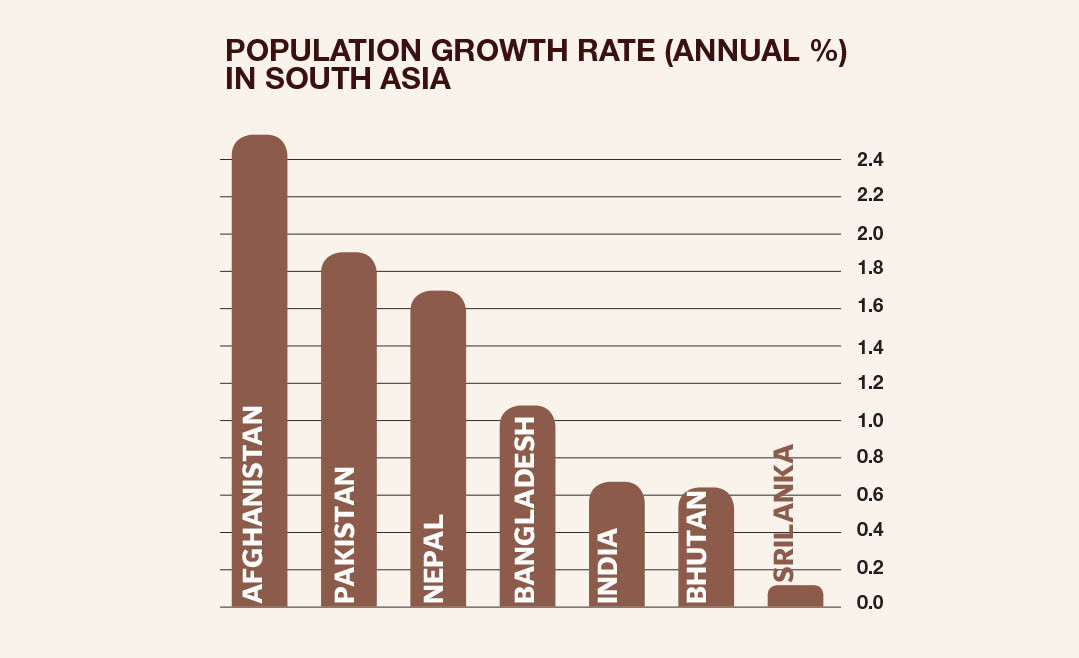
Success stories and lessons for Pakistan
Bangladesh's efforts in population control have given rise to remarkable results. From a fertility rate of around 6.3 in the 1970s, the country has successfully reduced it to 2.1, as of the latest available data. This achievement is considered a significant milestone, as a fertility rate of 2.1 is considered the replacement level, where the population size stabilises.
To achieve such success, Bangladesh focused on empowering women and enhancing their access to education and healthcare, leading to an increase in women's participation in the workforce. Educated and empowered women are more likely to make informed decisions regarding family planning, leading to reduced birth rates.
Moreover, Bangladesh's efforts in improving healthcare and reducing child mortality also contributed to population control. When families have confidence in the survival of their children, they tend to have fewer children.
Furthermore, the contraceptive prevalence rate (CPR) in Bangladesh is higher than that of Pakistan. CPR measures the percentage of married or in-union women aged 15 to 49 who are using, or whose sexual partner is using, any method of contraception. Bangladesh's CPR stands at 65.0%, while Pakistan's CPR is 34.1%. This substantial variation reflects the disparity in family planning services and awareness between the two countries.
Challenges Posed by Population Growth in Pakistan
Pakistan's rapid population growth has led to various challenges, including increased pressure on resources, inadequate healthcare facilities, and a strain on educational institutions ― overcrowded classrooms and insufficient resources hinder the delivery of quality education. The demand for food, water, housing, and energy has surged, leading to resource scarcity and environmental degradation.
The healthcare system faces difficulties in providing quality services to the growing population. Maternal and child mortality rates remain high, and the burden of disease has intensified.

Causes of high population growth in Pakistan
Lack of family planning and birth control The lack of sufficient family planning and birth control measures stands as a significant factor contributing to the country's rapid population growth. A prevalent issue, particularly in rural areas, is the limited awareness and reluctance to adopt modern contraceptive methods. As a result, many families have larger numbers of children than they can adequately support. The absence of accessible family planning services and comprehensive education on reproductive health leads to unintended pregnancies and exacerbates the strain on resources, healthcare, and education systems. Empowering individuals with the knowledge and tools to make informed decisions about family planning will not only help curb the population growth but also improve the overall well-being and prosperity of Pakistan's communities.
High infant mortality rate: Historically, Pakistan has grappled with high infant mortality rates, primarily attributed to limited access to adequate healthcare and sanitation facilities. This unfortunate reality compelled families to have larger numbers of children, as they hoped some would survive to adulthood. While progress has been made in recent years to improve healthcare and reduce infant mortality, this past reality continues to influence population growth patterns. The fear of losing children at a young age still resonates with many families, leading to a preference for larger family sizes as a form of insurance against the uncertainties of infant survival. By ensuring better survival prospects for infants, Pakistan can gradually shift towards a more sustainable population growth trajectory.
Low literacy rate and education: The persistently low literacy rate, particularly among women, plays a significant role in driving higher population growth. The lack of access to education limits individuals' understanding of the importance of family planning and reproductive health. Educated individuals are more likely to comprehend the benefits of smaller family sizes, leading to informed decisions about family planning and birth control. However, the prevailing educational disparities, particularly in rural and marginalised communities, hinder the dissemination of crucial information about reproductive health and family planning. Empowering both men and women with education and knowledge is essential to breaking the cycle of high population growth. By investing in quality education, promoting gender equality, and advocating for comprehensive reproductive health education, Pakistan can pave the way for a more informed and empowered society, contributing to sustainable population management and overall development.
Social and cultural norms: Social and cultural norms have a profound impact on shaping reproductive behaviours, particularly in certain communities where having many children is seen as a symbol of prestige and family honor. These deep-rooted traditions often prioritise larger family sizes, perpetuating the notion that having numerous children signifies prosperity and social standing. Consequently, there is limited acceptance and understanding of family planning methods within these communities. Challenging these norms requires sensitively addressing cultural beliefs and engaging community leaders to promote awareness about the benefits of smaller family sizes and comprehensive family planning. Encouraging open dialogues about reproductive health and breaking the stigma surrounding birth control can empower individuals to make informed choices about their family size, contributing to a more sustainable population growth in Pakistan. By combining culturally sensitive approaches with education and advocacy, the nation can gradually shift away from excessive population growth and foster a society where reproductive decisions are based on informed choices rather than social pressures.
Religious beliefs and practices: In Pakistan, religious beliefs and practices play a significant role in influencing population growth. As a country where religion holds immense significance in the lives of its people, certain interpretations of religious teachings may encourage larger families. Some religious beliefs emphasise the importance of procreation and view children as a blessing and a source of divine favor. Consequently, these interpretations may contribute to a cultural preference for larger family sizes within religious communities. It is essential to recognise the sensitivity of religious beliefs and engage in constructive dialogues to promote understanding about family planning and reproductive health. By fostering a balanced approach that respects religious values while also advocating for informed reproductive choices, Pakistan can work towards addressing population growth in a way that is culturally respectful and sustainable. Education and awareness campaigns can play a crucial role in highlighting the importance of family planning and empowering individuals to make decisions that align with their religious beliefs and personal circumstances.

Effects of high population growth
The rapid increase in population has various consequences for Pakistan:
Pressure on resources With expanding population, the demand for essential resources such as water, food, and energy has reached unprecedented levels, exerting immense strain on the country's already limited natural reserves. The growing needs of its people are putting a considerable burden on the infrastructure and the environment, threatening the sustainability and equilibrium of vital ecosystems.
Unemployment and poverty The challenge of high population growth exacerbates the pressing issues of unemployment and poverty. With a rapidly expanding workforce, the economy finds it increasingly difficult to generate enough jobs to accommodate the influx of job seekers. As a result, unemployment rates soar, leaving a significant portion of the population struggling to secure stable and dignified livelihoods. The lack of employment opportunities directly contributes to the persistence of poverty, trapping many individuals and families in a cycle of economic hardship.
Strain on healthcare and education The escalating population places considerable strain on the healthcare system and education infrastructure, posing significant challenges in providing essential services to all citizens. As the population expands, the demand for healthcare services increases, stretching the already limited resources and facilities to their limits. Access to quality healthcare becomes more difficult for many, particularly in remote and underserved areas, leading to disparities in healthcare outcomes. Similarly, the education sector faces similar challenges, with a surge in the number of students overwhelming schools and colleges. As a result, maintaining the standard of education becomes a daunting task, hindering the country's ability to provide equal educational opportunities to all.
Environmental impact The mounting population has significant environmental implications, giving rise to increased waste generation and pollution, which, in turn, exacerbates environmental degradation and contributes to the effects of climate change. With more people producing waste and demanding resources, the pressure on natural ecosystems intensifies. Improper waste management practices strain the environment, as landfills overflow and pollution contaminate air, water, and soil.
The accelerated pace of urbanisation further encroaches on green spaces and exacerbates deforestation, threatening biodiversity and ecological balance. Moreover, the escalating emissions from industries, transportation, and energy consumption contribute to climate change, resulting in extreme weather events, erratic rainfall patterns, and rising temperatures. Addressing these environmental challenges requires a concerted effort from the government, industries, and individuals to adopt sustainable practices, promote renewable energy, implement effective waste management systems, and foster environmental awareness and conservation efforts to safeguard Pakistan's natural heritage for future generations.
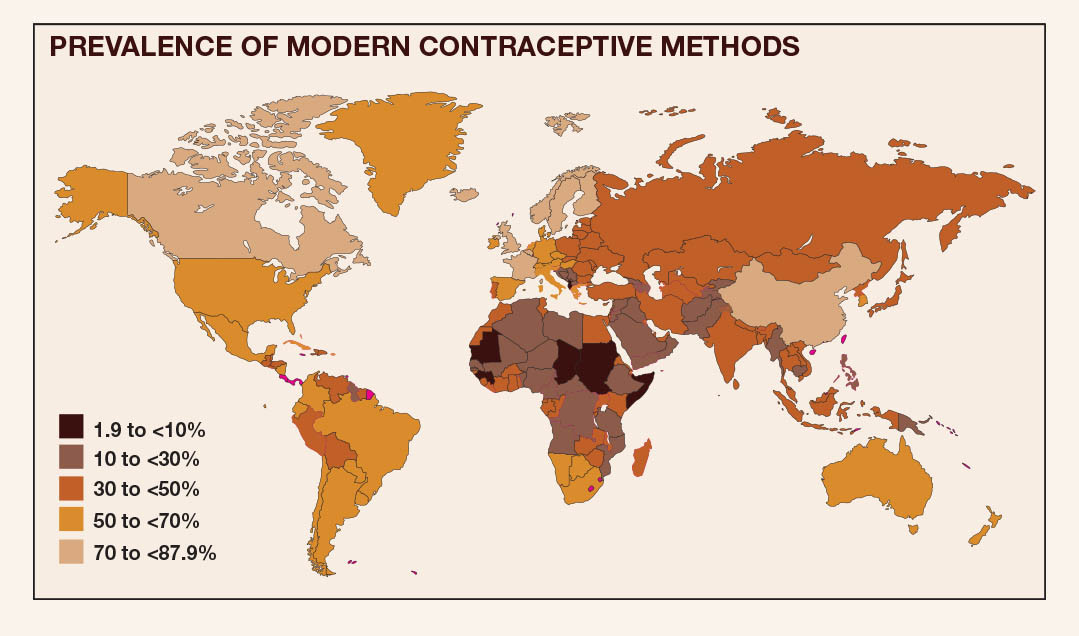
Policies to counteract underlying causes of high population growth in Pakistan
Family planning and awareness programmes: To control population growth effectively, Pakistan must prioritize family planning and create awareness about its benefits. Family planning allows individuals to make informed choices regarding the number and spacing of their children, leading to healthier and more sustainable families.
Educational campaigns on family planning, contraception, and reproductive health should be promoted through various media platforms and community outreach programs. Engaging religious leaders and influencers in these campaigns can help dispel misconceptions and myths surrounding family planning methods.
Women empowerment and reproductive rights: When women are educated, financially independent, and have access to reproductive healthcare, they can make informed decisions about their reproductive choices. Investing in women's education and healthcare is an investment in the future of the country. Furthermore, ensuring women's reproductive rights is essential for population control. Women should have the right to decide when and how many children they want to have, empowering them to break free from traditional norms and achieve their aspirations.
Healthcare and child mortality: Pakistan must invest in improving healthcare infrastructure, ensuring access to quality healthcare services for all citizens, especially in rural areas. Reducing child mortality rates is directly linked to population control. When families are assured of their children's survival, they are more likely to have fewer children. Pakistan can learn from Bangladesh's successful efforts in reducing child mortality and implement similar strategies to achieve positive outcomes.
Economic implications of population growth: Population growth has significant economic implications for Pakistan. A rapidly growing population poses challenges to economic development, as the demand for jobs and resources increases. Investing in education, skill development, and job creation is essential to harnessing the demographic dividend.
Urbanisation and rural development: Balancing urban and rural development is crucial to controlling population growth. Providing adequate opportunities and facilities in rural areas can discourage mass migration to urban centers. This balanced approach ensures that resources are distributed more equitably, leading to a more stable population growth pattern.
The take home
Knowledge holds the key to recognising the severity of Pakistan's population challenge and aiding the government in tackling this critical issue. Women's empowerment emerges as a potent force in curbing population growth rates, while raising literacy levels is crucial to achieving our population control goals. Singapore and China's successful adoption of two-child and one-child policies offer valuable lessons. To combat poverty, disparity, and other pressing problems, Pakistan must prioritise population regulation as the initial step. Meaningful discussions on family planning are imperative. Our resources are depleting, cities overcrowded and polluted, and the environment deteriorating. Pakistan's multiple woes, from poverty to climate change, are exacerbated by unchecked population growth. We must act now to unlock Pakistan's potential and address the social and economic challenges that lie ahead.

Overpopulation in Pakistan; Causes Consequences and Solutions

- January 18, 2023
- Overpopulation in Pakistan; Ca ...

Table of Contents
Pakistan is facing a population growth rate that is among the highest in the world. As of 2021, the population of Pakistan is estimated to be around 220 million, and it is projected to continue growing rapidly in the coming years. The country’s high population growth rate is driven by several factors, including a high fertility rate, a young population, and a lack of access to family planning services. Overpopulation in Pakistan has led to a number of challenges, such as increased competition for resources, overburdened infrastructure, and a strain on public services. The government of Pakistan has implemented several policies and programs to address these challenges, such as increasing access to family planning services and promoting education and economic development.

Causes of Overpopulation in Pakistan
The causes of overpopulation in Pakistan are complex and multifaceted. Some of the main factors include:
- High fertility rate: Pakistan has a relatively high fertility rate of around 3.3 children per woman, which is significantly higher than the global average.
- Lack of access to family planning services: Many people in Pakistan do not have access to family planning services, which makes it difficult for them to control the size of their families.
- Cultural and religious beliefs: Some cultural and religious beliefs in Pakistan discourage the use of birth control, which can contribute to high fertility rates.
- Poverty and lack of education: Poverty and lack of education are also major factors that contribute to high fertility rates in Pakistan. People who are poor or have limited education are less likely to have access to family planning services and may not have the knowledge or resources to control their fertility.
- Urbanization: Urbanization has also led to overpopulation in Pakistan as people migrate to the cities for job opportunities and better living standards.
- Political instability and lack of government action: Political instability and lack of government action in promoting family planning and education also play a role in overpopulation in Pakistan.
Consequences of Overpopulation in Pakistan
The consequences of overpopulation in Pakistan can be far-reaching and have a significant impact on the country’s social, economic, and environmental well-being. Some of the main consequences include:
- Strain on resources: Overpopulation puts a strain on resources such as food, water, and energy, leading to shortages and higher prices.
- Environmental degradation: Overpopulation can lead to environmental degradation, including deforestation, air and water pollution, and loss of biodiversity.
- Overburdened infrastructure: Overpopulation can lead to overcrowding, which can put a strain on infrastructure such as roads, housing, and public transportation.
- Economic challenges: Overpopulation can lead to increased competition for jobs, which can lead to higher unemployment rates and lower wages. It can also lead to a strain on public services, such as healthcare and education, which can make it more difficult for people to access these services.
- Social challenges: Overpopulation can lead to increased crime, poverty, and social unrest. It can also put a strain on social services, such as housing and welfare programs, which can make it more difficult for people to access these services.
- Health problems: Overpopulation can lead to poor living conditions and lack of access to healthcare, which can increase the risk of disease and illness.
- Political instability: Overpopulation can lead to political instability, as the government may struggle to meet the needs of a rapidly growing population.
It is important for Pakistan to take action to address these consequences, such as promoting family planning and education, increasing access to resources, and promoting sustainable development.
Solutions of Overpopulation in Pakistan
There are several solutions that can be implemented to address the issue of overpopulation in Pakistan. Some of the main solutions include :
- Promoting family planning and reproductive health: Increasing access to family planning services and providing education on reproductive health can help people to control the size of their families and reduce the rate of population growth.
- Education and economic development: Investing in education and economic development can help to reduce poverty and improve the overall well-being of the population. This can also lead to a reduction in the fertility rate as people become more aware of family planning and have more resources to support smaller families.
- Encourage urban planning: Encouraging urban planning and development can help to alleviate the strain on infrastructure and resources in urban areas. This can also help to improve living conditions and reduce overcrowding.
- Improve living standards and access to resources: Improving living standards and access to resources such as housing, healthcare, and education can help to reduce poverty and improve overall well-being. This can also help to reduce the fertility rate.
- Government policies: Government policies such as tax incentives for smaller families, and penalties for having more than a certain number of children, can also be implemented to help control population growth.
- Promoting sustainable development: Encouraging sustainable development and environmental protection can help to reduce the strain on resources and protect the environment. This can also help to improve overall well-being and reduce the rate of population growth.
It’s important to note that a comprehensive and integrated approach is needed to address the issue of overpopulation in Pakistan, involving government, civil society, and international organizations.
Further Readings
Child Labour in Pakistan; Causes, Consequences and Solutions
Corruption in Pakistan; Causes, Consequences and Solutions
Unemployment in Pakistan; Causes, Consequences and Solutions
Poverty in Pakistan; Causes, Consequences, Solutions
Economic Challenges of Pakistan
Education System of Pakistan: Challenges and Way Forward
Pakistan Healthcare System Challenges and Solutions

Admin at The Pakistan Gazette
- Admin https://thepakistangazette.com/author/admin/ Parliamentary System Merits for Pakistan
- Admin https://thepakistangazette.com/author/admin/ Middle East Conundrum
- Admin https://thepakistangazette.com/author/admin/ Hamas Israel Conflict Implications for Region
- Admin https://thepakistangazette.com/author/admin/ Pakistan's Economic Challenges
Leave a Reply Cancel reply
Your email address will not be published. Required fields are marked *
Save my name, email, and website in this browser for the next time I comment.
© 2021. All rights reserved by Your Company.
Introduction
- Director General
- ISSI Partners
- About the Journal
- Aim & Scope of the Journal
- Editorial Team
- Editorial Advisory Board & Editorial Board
- Journal’s Archive
- Review and Publication Guidelines
- Ethical Guidelines
- Plagiarism Guidelines
- Indexing & Abstracting
- Call for Papers
- Issue Briefs
- Special Guest Articles
- Tuesday Dialogue
- Conference Reports
- Combating Corona
- Islamabad Papers
- Young ISSI Professionals Corner
- Annual Reports
- Vision & Functions
- Advisory Board – China Pakistan Study Centre (CPSC)
- Pivot Magazine
- CPSC Monitor
- ACDC Vision
- ACDC Functions
- News & Views
- ISC Functions
- ISC Monitor
- CAMEA Vision
- CAMEA Functions
- CAMEA Bulletin
- CSP Functions
- ISSI Library
- HEC Digital Library
- Events Archive
- Upcoming Events
- Press Releases

Roundtable Discussion on the “Importance of Global Solidarity to Combat Islamophobia”

Roundtable Discussion on “Women’s Inclusion in Policy Discourse of Pakistan”

ISSI Next-Generation International Security Experts Conference 2024

Seminar on “Global Security Initiative (GSI): China’s World View”

پریس ریلیز -آئی ایس ایس آئی نے سفیر ڈونلڈ بلوم …

Press Release – ISSI Hosts Roundtable Discussion with Ambassador Donald Blome…

پریس ریلیز -آئی ایس ایس آئی نے “اسلامو فوبیا سے نمٹنے…

Press Release – ISSI hosts Roundtable on the “Importance of Global…

پریس ریلیز-آئی ایس ایس آئی نے رَشیٔن فیڈریشن کے سفیر کا…
- ISSI Publications Articles
Issue Brief on “Pakistan’s Rising Population Crisis”
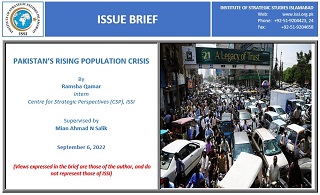
Population growth has always been a central point of concern for many. While many believe that the high population is an asset for Pakistan, unfortunately this is a far stretch from reality. Today, in the 21 st century, Pakistan and a handful of its neighbours are the core states under risk of the fallouts of overpopulation. Amongst these are climate change, food scarcity, and insufficient energy and resources.
At the time of its independence, Pakistan had a population of 31 million. However, by the year 1995 the number had risen at a staggering speed and reached 140 million. [1] Presently, Pakistan has a population size of 225,199,929 with a growth rate of 1.9%. [2] The United Nations has predicted that at this rate Pakistan will hit the 380 million marker by 2050. [3]
RELATED ARTICLES MORE FROM AUTHOR

Issue Brief on “Confucius Institutes Shaping China’s Soft Power”

Issue Brief on “Drones: The New Frontier in Geopolitical Arena”

Issue Brief on “Analyzing Discrepancies in U.S. Media Coverage of Russian and Israeli Invasions”
Recent publications.

Strategic Studies (Vol. 43, Winter 2023, No. 2)

Strategic Studies (Vol. 43, Summer 2023, No. 1)

Strategic Studies (Vol. 42, Winter 2022, No. 2)

Strategic Studies (Vol. 42, Summer 2022, No. 1)

Strategic Studies (Vol. 41, Winter 2021, No. 4)
Causes Of Overpopulation In Pakistan
In human biology, the total number of people living in a given area (such as a country or the entire world) is constantly changing due to both increases and decreases in deaths and migrations. The terms “overpopulation” and “population explosion” are used to describe the idea of a growing population with dwindling resources.
Pakistan’s total population is 177.1 million, up from 173.5 million the previous year, according to the Pakistan Economic Survey 2010-11. Pakistan ranks sixth among the world’s most populous countries, with a population growth rate of 2.1 percent. Now let’s discuss the main causes of overpopulation in Pakistan.
The following are the main causes of Pakistan’s overpopulation:
Table of Content
Raziq is ALLAH
Muslims believe that God provides food for everyone, including an ant living in a stone. So, why do they reduce family size? 71 percent have a no or low opportunity cost. In Pakistan, women do not participate in economic activities. Women do not suffer any financial losses as a result of having a child. In Pakistan, the cost of having a child is very low, if not zero.

Low Income Per Capita
Per capita income is calculated by dividing national income by the total population. Low per capita income indicates population growth. Pakistan’s per capita income is $ 1254.
Unemployment
It is a term used to describe the state of being unemployed. Unemployment is also seen as a sign of overcrowding. It is difficult to adjust economic activities to accommodate such a large population. Pakistan has a 5.6 percent unemployment rate.
Extremely Rapid Population Growth
The birth rate is extremely high, indicating that our country is overcrowded. Pakistan has a population growth rate of 2.1 percent.
More Earning Hands Are Required
In developing countries like Pakistan, a single person cannot support his large family. He believes that having more children will provide him with more earning potential.
Afghan Refugees
The influx of refugees from India, particularly Afghanistan, has resulted in an increase in population.
Relatively Low Death Rate
Another cause of overpopulation is a decrease in the death rate. In 1951, the death rate was 2.8 percent, but in 2010-11, it was only 0.73 percent.
Low Living Standards
It has been observed that low-income Pakistanis have more children. It is difficult to provide for such a large family. As a result, the population’s living standards are low.

Warm Weather
Because of the warm climate, youth and maturity come early in life. It also has the effect of causing rapid population growth.
Family Planning Isn’t Available
In Pakistan, there is no effective family planning. The methods of family planning are unfamiliar to most people. They are hesitant to seek medical advice.
Joint Family System
In a joint family system, there is competition among family members based on the size of the family. It is also a factor in children’s rapid growth.
Early Marriages
In Pakistan, marriages usually take place between the ages of 16 and 22. The time it takes to re-productivity is extremely long. Consult Gynecologist if you need any information on early reproductivity.
It is a condition in which a person is unable to read or write. People are unaware of the economic problems caused by a high birth rate due to a lack of education. Pakistan has a literacy rate of 57.7%.
Population Inefficiency
In our county, the dependency ratio is extremely high. Only 32.17 percent of the population participates in economic activities, while the remaining 67.83 percent relies on them. It sees land pressure and population expulsion as a problem.
Polygamy Experimentation
Polygamy is the state or practice of having multiple wives at the same time. Polygamy is another factor that contributes to population growth.

Urbanization
It is the first step in the process of becoming a city. Many social issues exist as a result of rural-urban migration and a lack of infrastructure in cities. As a result, the urban population increases. Overpopulation is indicated by a higher rate of urbanization.
Low Savings and Investing
In Pakistan, the savings and investment rates of GDP are only 9.5 percent and 13.4 percent, respectively. Because of the low rate of savings, the rate of investment and employment is also very low. As a result, these figures suggest that Pakistan is overcrowded.
Inadequate Nutrition
People in Pakistan have a poor diet, which has an impact on their health and ability to work. It lowers per capita income, indicating a population explosion.
Large Family Concept
Large families are thought to be a source of power for influencing and controlling those around them. People are proud of their large families.
Vicious Poverty Circle
A rapid increase in the population reduces per capita income, savings, investment, and productivity. As a result, a country is trapped in a vicious cycle of poverty. Poverty’s vicious circle is also a symbol of overpopulation.
Marriage Universality
Wedlock is entered into by all men and women of marriageable age. As a result, Pakistan’s birth rate is higher.
Lack of Alternative Activities
In Pakistan, recreational facilities and employment opportunities are scarce. In Pakistan, passing the time and any other pleasures are prohibitively expensive. As a result, men have more time with their wives.
Ending Notes
In developing countries like Pakistan, a high population growth rate has negative consequences for economic development. In Pakistan, a high rate of population growth means poverty, illiteracy, a low standard of living, a lack of prosperity, and a vicious cycle of poverty. Consult Gynecologist for any information on reproductivity.
Book an appointment now, to answer all your queries. You can book an appointment with the top gynecologists in Pakistan through Marham or get appointment by calling at Marham helpline: 0311-1222398 or by online booking facility through the website or Marham mobile app.
Can’t Find The App?
What are the primary causes of overpopulation.
- Falling Mortality Rate.
- Underutilized Contraception.
- Female Education Deficit.
- Degradation of the environment.
- An increase in the number of conflicts.
- Disasters and pandemics are more likely.
What are the consequences of Pakistan’s overpopulation?
In developing countries like Pakistan, a high population growth rate has negative consequences for economic development. In Pakistan, a high rate of population growth means poverty, illiteracy, a low standard of living, a lack of prosperity, and a vicious cycle of poverty.
What are the four factors that contribute to poverty?
Unequal wealth distribution, disease, colonization and past inequalities, as well as bad governance and corruption* are four factors that contribute to poor living conditions.

Rida Faqeer Muhammad is a psychology student and content writer with a deep understanding of human behavior and a talent for creating engaging and informative content. With a bachelor's degree in Psychology and a Master's in Speech and Language Pathology, she combines her knowledge of psychology with strong writing skills to produce well-researched articles, blog posts, and social media content. Rida's expertise lies in conducting thorough research, delivering polished and high-quality content, and adapting writing styles for various audiences and platforms. Her content strategies, developed with a focus on SEO optimization, ensure maximum visibility and engagement. With a passion for personal development and wellness, her work resonates with readers and offers practical insights. Her ability to translate complex psychological concepts into accessible content makes her a valuable contributor in the field.
Related Posts
5 surprising anarkali fruit benefits – anarkali fruit in english, medicine for periods pain in pakistan – why pain in periods in urdu, 7 best ibs medicine in pakistan to relieve ibs symptoms.
Comments are closed.
Type above and press Enter to search. Press Esc to cancel.
This site uses cookies to optimize functionality and give you the best possible experience. If you continue to navigate this website beyond this page, cookies will be placed on your browser. To learn more about cookies, click here .
- Get Involved
- English pdf (1.1 MB)
- URDU Part I pdf (22.4 MB)
- URDU Part II pdf (22.2 MB)
Population Growth: Implications for Human Development
September 2, 2019.
Pakistan is the sixth most populous country in the world with its population estimated at 207.8 million in 2017. Its population growth rate of 2.40 percent is the highest in South Asia and stands in sharp contrast to the 1.0–1.5 percent growth rate of other South Asian countries. Pakistan's population has increased by more than six-folds since the first post-independence census held in 1951. This massive growth in population possesses serious challenges for the country's socio-economic development.
The high growth in population could be attributed to a number of factors. Pakistan has the lowest contraceptive prevalence rate in South Asia, which has stagnated at 35 percent over the last couple of years. One in five married women in Pakistan are unable to access effective methods of family planning if they want to avoid pregnancy and plan the number and spacing of children. Low contraceptive prevalence may be further attributed to weak service delivery systems and markets and cultural norms.
Between 1993 to 1998, Pakistan ran a successful family planning programme which was instrumental in reducing fertility rates and increasing contraceptive prevalence. The key element of the programme was the recruitment of trained Lady Health Workers (LHW) to provide primary health care and family planning services to women at community level. The LHW were pivotal in expanding family planning services to the poor and educating them on the available methods. However, from 2000 onwards, successive governments' attention to family planning programmes started to reduce.
However, it is encouraging to note that population and family planning is now again getting space on the government's policy agenda. The Federal Government has constituted a Task Force on Population and Family Planning to develop a strategy for controlling population growth and guiding its implementation. The Task Force, headed by the Prime Minister which includes all provincial Chief Ministers as members, is working towards three key targets; increasing contraceptive prevalence rate to 55 percent, reducing fertility rate from 3.6 births per woman to 2.1, and decreasing population growth rate to 1.5 percent. Given the devolved governance structure in Pakistan, the inclusion of Chief Ministers in the Task Force is key to implementing a coordinated and comprehensive family planning programme.

Regions and Countries
Related publications.

Publications
Undp pakistan annual report 2022.
2022 will be remembered as a critical, trying year for Pakistan, with growing macroeconomic and fiscal concerns, a cost of living crisis impacting the most vuln...

UNDP Pakistan Annual Report 2021
In 2021, UNDP continued its long-standing partnership with Pakistan to achieve its development goals and to ensure that no one is left behind. At the reque...
Financing Climate Action in Pakistan: Solutions and Way F...
FINANCING A GREEN FUTURE Climate change is the gravest challenge of our time and how fast and extensively it is transforming the world does not need to be su...
Inclusive Growth in Times of Uncertainty
Changing Gears on Economic Policy "Innovations in economic foresight point towards a fundamental emerging need to align economic growth with diversified deve...

The Development Imperative: Media to Engage, Educate, Emp...
The word media, originating from the Latin ‘medius’, speaks to the quality of being ‘in between’. Thus, media implies the relaying of information between the so...
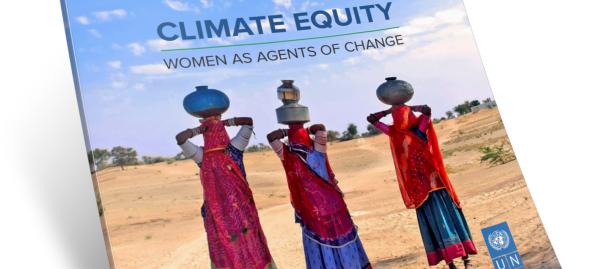
Climate Equity: Women as Agents of Change
The “Climate Equity: Women as Agents of Change” Report has been jointly produced by the National Commission on Status of Women and UNDP Pakistan. The findings o...
- nawaiwaqt group
- Roznama Nawaiwaqt
- Waqt News TV
- Sunday Magazine
- Family Magazine
- Nidai Millat
- Mahnama Phool
- Today's Paper
- Newspaper Picks
- Top Stories
- Lifestyle & Entertainment
- International
- Editor's Picks
- News In Pictures
- Write for Us
Challenges of overpopulation in pakistan
The surge in human resources demands parallel growth in a nation’s population, playing a pivotal role in its economic and social trajectory. In Pakistan, this intricate relationship manifests as both a producer and a consumer of human capital. The consequential strain on resources has rendered the country economically strained. The sheer magnitude of the population impedes the government’s ability to meet the escalating demands for goods, leading to a worrisome imbalance in supply and demand and subsequently, soaring inflation.
To address this conundrum, it is imperative for the government to implement strategic measures. Instituting restrictions on family size is a practical step to mitigate the strain on resources. Encouraging a limit to the number of children per family, perhaps to just two, can pave the way for a more sustainable demographic landscape. Such measures are essential for steering Pakistan away from the brink of overpopulation and fostering a balanced environment for economic and social development.
PM lauds Army, Police for ensuring law & order during Eid
SOBAN ASHRAF,
Related News
Commissioner reviews arrangements for eid, baisakhi festival, remote areas now integrated into fto network, says meher, ichhra incident: atc grants bail to two accused, cm maryam directs foolproof security arrangements on eid, lesco detects 307 power pilferers, kh salman chairs meeting of sub-cabinet committee, ruling alliance wins top senate slots amid pti boycott, noisy protest, pm hints at imposings education emergency in country, muslims across the world celebrate eid-ul-fitr today, us concerned over reports of pakistanis killings by india, opposition’s anti-govt protests on the cards, senators to elect chairman, deputy today as pti announces boycott, bushra bibi meets pti founder in adiala jail, president zardari offers eid prayers in nawabshah, pm shehbaz offers eid prayers in lahore, president zardari, pm shehbaz exchange eid greetings, bollywood: a political pawn, how not to lead universities, challenges of climate change & cop29, flux in universities.
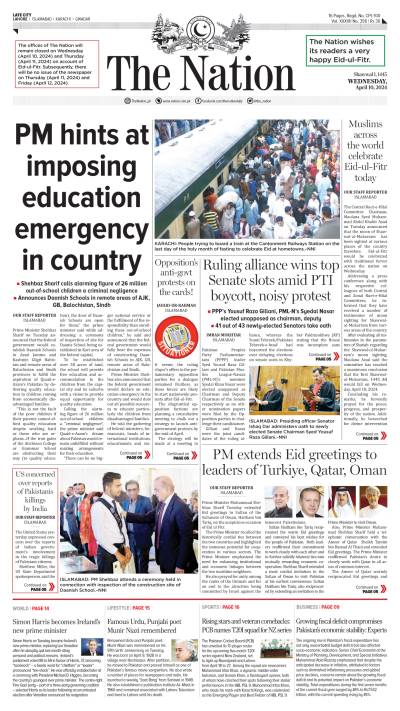
Combatting disinformation in Pakistan
Role of nature-based solutions for improving ..., role of nature-based solutions for improving urban water ..., the orange crow: preparing to spread its ..., the orange crow: preparing to spread its vibrant wings, the solution, citizenship amendment act - muslims under ..., citizenship amendment act - muslims under threat in modi's ..., germany’s shame, saudi investment, coalition partner, safe returns, narcotics challenge, cyber academic wellness, rural education heroes, political transitions reflections, peace advocacy, digital divide, epaper - nawaiwaqt.

Newsletter Subscription
Advertisement.

NIPCO House, 4 - Shaharah e Fatima Jinnah,
Lahore, Pakistan
Tel: +92 42 36367580 | Fax : +92 42 36367005
- Advertise With Us
- Privacy Policy
Nawaiwaqt Group | Copyright © 2024

The Overpopulation Crisis in Pakistan: Impacts, Causes, and Suggestions

- Zehra Ramzan
- November 16, 2021
- CSS , CSS Essays , CSS Solved Pakistan Affairs , Current Affairs , Over-population , Pakistan's Domestic Affairs , Pakistani Society , PMS , PMS Essays , Socio-economic problems
- 41158 Views
Pakistan faces a major socio-economic predicament due to a rapidly growing population caused by illiteracy, unemployment, patriarchal societal patterns, inept leadership, lack of proper awareness about birth control methods, etc. To circumscribe the overpopulation crisis prevalent in the country, pragmatic and result-driven designated steps ensuring improvement in the literacy rate, employment opportunities for youth, prohibition on child labour practices, efficient family planning programs, etc., are a must.

1. Introduction
Pakistan faces a major socio-economic predicament due to a rapidly growing population caused by illiteracy, unemployment, patriarchal societal patterns, inept leadership, lack of proper awareness about birth control methods, etc. To circumscribe the overpopulation crisis prevalent in the country, pragmatic and result-driven designated steps ensuring improvement in the literacy rate, employment opportunities for youth, prohibition on child labour practices, efficient family planning programs, etc., are a must.
2. Current Situation
- The current growth rate of the country is close to two per cent (2%)
- Nearly sixty per cent of people are under the age of thirty
- The population of the country is expected to rise to four hundred million by 2050
3. Impacts of the overpopulation crisis
- Lowering the living standard
- Giving rise to unemployment
- Perpetuating the cycle of poverty
- Exhausting natural resources
- Destroying country’s economy
- Increasing dependence on foreign aids
- The breeding dichotomy between classes
- Leading to degradation of the environment
- The emerging water crisis in the country
- Hindering agricultural development
4. Causes of the overpopulation crisis
- The poverty in the country
- High Illiteracy rate
- A patriarchal society
- A lack of awareness regarding birth-control
- The high immigrant ratio in the country
- Unemployment and lack of recreational activities
- Conservatism and misinterpretation of religious principles
- Technological advancements resulting in other related factors
- Polygamy
- Government’s inefficient policies
5. Suggestions to curb the overpopulation crisis
- To introduce effective family planning programs
- To empower women through education
- To remove the barriers to birth-control
- To put restrictions on child marriages
- To make improvements in the health sector
- To restraint child labour
- To focus on poverty reduction policies
- To introduce a proper management system for immigrants and refugees
- To encourage the positive role of scholars to propagate the true teachings of Islam
- To make contraception available and accessible for all
6. Critical Analysis 7. Conclusion

Introduction
The persistent rise in population, undoubtedly posing a severe challenge to the country’s socio-economic development and advancement, has wreaked havoc on Pakistan’s economic stability and growth. The alarming increase in population causes a considerable strain on the existing resources of the economy. Being a developing country, Pakistan faces a significant social, political, and economic predicament due to the uncontrolled population growth rate. According to the current estimates, Pakistan is the fifth most populous country, with its population estimated at 220.9 million in 2020, pinpointing the fact that the population of the country has increased by more than six-fold since the first post-independence census held in 1951. Accordingly, the unchecked growth of the population needs drastic measures and actions to circumvent its unprecedented expansion. In Third World countries like Pakistan, overpopulation amplifies and afflicts profound suffering to the well-being of people. Therefore, addressing the issue of population explosion and tackling its resultant effects is the immense need of the hour.
The overpopulation crisis has led the country to the brink of an economic explosion. Unsurprisingly, the severity of the issue is taking its foothold with significant negative consequences. According to the recent report, the current growth rate of the population is close to two per cent (2%), making Pakistan have the highest birth rate in South Asia after India, i.e., twenty-two births per thousand people. In contrast, the death rate stands at 7.228 per 1000. According to the United Nations report, due to the high birth rate, its population is expected to rise to 400 million by 2050, doubling its current number. Ironically, the situation has constantly been pulling the country’s youth into the vortex of unemployment, as the people of Pakistan under the age of thirty are about 60 per cent (60%).
Although the repercussions of overpopulation have always been threatening for a developing country, the way the crisis has started impacting Pakistan is scarier. Following are the major impacts, highlighting the severity of the problem in the country.
It is a fact that the standard of living is determined by the per capita income and the economic growth of a country. However, in the present world, the population explosion overpowers every other crisis, particularly in underdeveloped countries; in consequence, it gives rise to an increase in demands for basic provisions of life: food commodities, shelters, and clothes, etc. With the immense population growth, it becomes an arduous task for such a country to create equilibrium in society. Similarly, in Pakistan, an economically struggling nation, the crisis disturbs the standard of life by jolting the demand and supply mechanism. Grievously, the supply cannot be increased due to the lack of cooperating factors: skilled labour, job opportunities, good governance. Further, Pakistan, being an underdeveloped country, faces inflation, which, in turn, increases the cost of living of the people. As per statistics of Trading Economics Global Macro Models, the inflation rate in the country is expected to reach eight percent (8%) by the end of 2021. On the one hand, fewer resources, less drinking water, unmanaged urbanization, and unemployment provoke an increase in the cost of living; on the other hand, only a number of people can fulfil their needs to survive. Hence, population growth curtails the standard of living, but checking population growth can lead to a more balanced society. As aptly said by Dr Umbreen Javaid,
“Growing population size is decreasing the standard of living.” Dr Umbreen Javaid
Moreover, overpopulation severely affects a country by destroying its socio-economic fabric. When an underdeveloped country fails to handle and manage the crises, it, ultimately, seeks help from other countries. Similarly, Pakistan has to depend upon foreign organizations to run its affairs. According to the State Bank of Pakistan, the country’s external debt has reached 116.3 billion (USD) in Mar 2021, an increase of nearly one percent from the previous year. Although the aid fills the investment gap and increases productivity, it is observed that foreign aid does not benefit the country significantly because it is apparent from the dreadful situation of communal sectors, including health care, employment, and education, etc. Moreover, the funding is not interest-free; therefore, it crushes the backbone of an already stagnant economy. Thus, from the above arguments, it can be said that the overpopulation crisis handicaps a country both economically and socially.
Besides that, high population growth seems to be a major contributor to the vicious cycle of poverty in developing economies. People are compelled to spend a significant portion of their income, whatever they earn, on the upbringing of their children. As a result, in Pakistan, savings and capital formation rates remain low, which gives rise to poverty. As per the World Bank estimates, based on the lower-middle-income poverty rate, Pakistan’s poverty rate is 39.3 percent in 2020-21 and is expected to be the same in 2021-22. Furthermore, the decrease in per capita income and increase in the overall price level result in a significant increase in the cost of living, encapsulating the country with poverty. Hence, to curb the menace of poverty, the government must take steps to make improvements in the agricultural and industrial sectors to reduce the shortage of essential commodities, improve the standard of living, and find solutions for mass unemployment. As Ishrat Hussain says,
“The rapid growth of the population is accounting for poverty.” Ishrat Hussain
In addition, the overpopulation crisis in Pakistan is the root cause of the emerging water shortage in the country. The global water crisis report of the United Nations (UN) has placed Pakistan in the fourteenth position among the countries facing extreme water scarcity. Rising population, along with rapid urbanization and climate change, is the cause of the widening gap between water availability and water requirement. In addition, the International Monetary Fund (IMF) has placed Pakistan in the third position among the countries facing acute water shortages. Around 80 percent of the people living in 24 major cities of Pakistan do not have access to clean drinking water; in the slums of Karachi, 16 million do not have access to safe drinking water. Thus, the water crisis is a severe consequence of overpopulation in Pakistan, which is to put the country on the verge of an extremely disastrous situation.
Similarly, an explosion in population gives rise to the large number of people coming to the labour market; however, an economically struggling country cannot provide employment to all. As a matter of fact, despite all endeavours towards strategic developments, it is not feasible to employ everyone because the number of job seekers expands exponentially. Likewise, in Pakistan, disguised employment, unemployment, and underemployment are common elements overshadowing the country. As per Statista research, in September 2021, the national unemployment rate is projected at 4.8 percent, and the unemployment rate increases every day. Nearly seven hundred thousand people are unemployed. As a result, the alarming rate of unemployed men and women contributes to rising crimes and social unrest. Therefore, the government must devise policies and introduce a wide range of employment opportunities and, above all, manage the population explosion crisis efficaciously to get rid of the menace. As Andrés Velasco, correctly, states,
“An increase in the size of the population is giving rise to unemployment in a country.” Andrés Velasco
Furthermore, the population explosion affects the per capita income of a country. The high growth rate lowers the per capita income; however, if it is up to the income optimizing level, it increases the same. Accordingly, the economic growth rises, if the rate of population growth is less than the per capita income of the country; whereas, when the population rate exceeds the level of economic growth, mostly observed in the developing nations, per capita income falls. In the same way, being a developing country, Pakistani society faces a downfall in the economy due to the population crisis. As per a research published in the Journal of Economics, a one percent increase in population degrades GDP by 0.33 percent. For instance, food scarcity, caused due to overpopulation and other factors, affects economic development in many aspects. To begin with, a lack of food leads to undernourishment, which reduces people’s productivity. Further, they are forced to import agricultural goods due to a lack of food, putting pressure on their foreign exchange reserves. Hence, the impacts of overpopulation are intertwined and correlated that can be minimized by good governance and pragmatic policies.
In addition, the unequal and unrestricted use of natural resources is another undesirable and detrimental effect of overpopulation. The planet’s capacity to produce raw materials is limited and finite, and the natural deficit, the utilization of resources at a higher rate than the planet’s ability to generate them, approaches earlier each year. Thus, Pakistan, along with other external and internal threats, encounters the shortage and depletion of natural resources. For example, water is a natural resource; however, due to the high population growth rate, only thirty-six percent of the population has access to safe water, a problem likely to get worse in the coming years, as per some authoritative reports. Therefore, the government of Pakistan must make and implement policies to manage resources and create a balance in society. John Muir, the Naturalist and Writer, says,
“Expanding the size of the population is depleting the natural deposits of the world.” John Muir, the Naturalist and Writer
Likewise, in poorly developed countries, most of the people live in rural areas, and they rely on agriculture for their living. But when the rate of population increases, the land-man ratio is disturbed. Likewise, in Pakistan, the rural population is reported at 62.84 percent in 2020, according to the World Bank collection. Accordingly, when the number of masses increases, the per capita availability of land for cultivation declines. As a result, this leads to unemployment and underemployment in the agriculture sector. Moreover, when the population rises, the agricultural land is used to build and develop houses, factories, hospitals, educational institutions, and highways; consequently, the proportion of area available for farming reduces. Thus, the population growth, at an exponential rate, hampers agricultural development and creates many other problems.
Also, overpopulation breeds dichotomy and contempt between the rich and poor. In the world of hustle and competition, everyone desires to lead others and wishes to have a successful life. However, the growing population gives rise to the scarcity of resources, which, in turn, puts a burden on the country’s economy, and a sense of deprivation prevails in the minds of the poor. The non-fulfilment of basic needs propels the poor towards rebellion and criminal activities. Antagonism and conflict arise due to population rise and competition; individualism, the prevalence of self-centred goals and objectives, weakens the solidarity and harmony in society. Hence, one can say that the overpopulation crisis weakens the unity among the people of a nation. As Edward Abbey says,
“A crowded society is a restrictive society; an overcrowded society becomes an authoritarian, repressive and murderous society.” Edward Abbey
Last but not least, the implication of overpopulation can also be seen in the environment. A colossal population affects the environment in two ways. First, the more the people, the rapid the consumption of natural resources, such as land, water, fossil fuels, and minerals; second, the swift the consumption, the more the waste produced, such as air and water pollutants, toxic industrial surplus, climate change, and the release of greenhouse gases in the atmosphere. In other words, it can be stated that the population explosion in the country accounts for overconsumption of resources; in consequence, the depletion of natural assets takes place, which, in turn, is to degrade the environment by putting extreme strain on both the renewable and non-renewable deposits. As aptly said by Jacques Yves Cousteau,
“Population growth is the primary source of environmental damage.” Jacques Yves Cousteau

There are many factors calling forth the population explosion in Pakistan. First, the role of illiteracy is the cardinal one in this regard. Unless the women are literate, no excessive child-birth control methods and policies can work out. Unfortunately, the education stats from the Economic Survey of Pakistan, conducted in 2017-2018, show that the literacy rate for women in the country is 48 percent, and, for men, it is 70 percent. Keeping in view the fact that education has strong links with the fertility rate of women, the situation becomes grave for the country. A well-educated, learned, informed woman is more receptive to family planning services and other birth control measures than an illiterate, unlearned, unaware woman. Thus, the poor state of women’s education in the country is one of the main culprits behind the high population growth rate. As perfectly said by Akbar Zaidi,
“Overlooking a woman’s education is giving rise to birth rates and population growth.” Akbar Zaidi
Second, poverty is also a leading cause of overpopulation. According to the report launched by the Ministry of Planning, Development, and Reform, nearly thirty-nine percent of people of Pakistan live in multidimensional poverty, the deprivations people experience based on health, education, and standard of living, with FATA and Balochistan having the highest rates of poverty.
Due to the lack of resources and fundamental provisions of life, the poor aspire for more children than the rich because they consider them means of employment. Judith Blake elaborates the fact eloquently; she says: ‘Those in the lowest economic status group desire a large family. This is so because children are regarded as economic assets and security in old age, even though it will mean more mouths to be fed.’ Thus, due to the financial debacle, many families keep adding more children in order to have more helping hands to get them out of poverty. As it is aptly said by Dr Hafeez Pasha,
“Living in poverty is bringing up the overpopulation crisis in a country.” Dr Hafeez Pasha
Third, the patriarchal society adds insult to injury. Although the country has progressed in nearly all fields, a lot of work still has to be done to break the shackles of patriarchy. In most parts of the country, men still dominate women. Ironically, women, who bear the brunt of childbirth, have no say in this regard; whereas, men, who do not even have to go through the cumbersome period of pre-and post-pregnancy, decide how many children they want. Moreover, the never-ending desire for maximum male children also results in excessive childbirths because girls are still not welcomed in many parts of the country. As Prof. Dr Amra Raza says,
“Controlling women and their environment is keeping birth rates high.” Prof. Dr Amra Raza
Fourth, the lack of awareness about excessive childbirth prevention methods is another reason for the monster’s rapid propagation in the country. According to World Health Indicators 2015, Pakistan has a contraceptive use rate of thirty-five percent, the lowest among all its neighbouring countries. One of the principal reasons behind the low CPR is that there is a lot of ambiguity and misconception about contraceptive use and other modern birth control methods. Some people think such treatments make women infertile for good, and others believe these measures cause damage to the recipient. Due to the above-mentioned reasons, women hesitate to undergo any such procedures; as a result, the population growth rate continues to increase. As correctly said by Akbar Zaidi,
“Lacking guidance about birth control measures is calling forth human explosion.” Akbar Zaidi
Fifth, immigration is also a glaring cause of overpopulation in Pakistan. According to UNHCR, the country, at present, hosts nearly 1.4 million registered Afghan refugees despite the tough socio-economic challenges it comes across, which adds up to the population of an already overpopulated country. As a result, the government remains unable to fulfil the necessities of people. In addition, most of the country’s funds are ploughed back to run the affairs of the state with a galloping population; in consequence, a little is left to be spent on its development. Because the country consumes more and saves less due to more people and scarce resources, improving the economy becomes a big hurdle for the government. As Ishrat Hussain, correctly, states,
“Adding up immigrants is fueling the high population growth rate.” Ishrat Hussain
Sixth, conservatism and misinterpretation of religious principles give impetus to the population explosion in Pakistan. Dogmatic and narrow-minded mullahs consider birth control measures against the spirit of Islam. Although Islam is the only religion that has universality, and teachings of Islam are for the needs of people of all the times and places of the world, people tend to interpret Islamic doctrines according to their self-interests. People in Pakistan, especially males, vindicate multiple marriages as a right the religion (Islam) has given to them; however, they do not give ample consideration to the limitations Islam has set for them. Hence, it can be said that a lack of apt elucidation of religious teachings gives rise to the increasing population of the country.
Seventh, unemployment and lack of recreational activities in the country add fuel to the fire. Currently, the number of unemployed people in the country has reached about 6.65 million during the fiscal year 2020-21. Pakistan, being an underdeveloped country, does not have many resources to provide people with business and creative opportunities; impoverished people, deprived of their fundamental provisions of life, give birth to more children so that they can have more earning hands. With scarce resources, people live from hand to mouth. In such a situation where they are lacking their basic necessities, chances of any recreational or enjoyment activities are at a premium. They spend most of their time at home; their life partner is the only source of enjoyment for them. As a result of their companionship, the population growth of the country further increases. As Akbar Zaidi, correctly, says,
“If we have the problem of overpopulation and unemployment at the same time, then things do not add up.” Akbar Zaidi
Eighth, polygamy, having more than one wife at a time, contributes to exponential population growth. One of the commonly held beliefs among Muslims is that God has given the right of polygamy to men; moreover, polygamy is legally permissible in Pakistan, according to the family law of 1961, but it is restricted to some obligations and legal regulations. Pakistan’s family law requires written permission from the first wife to marry again; furthermore, Islam allows multiple marriages to men only if they can be just to each of the women in their partnership. However, many men overlook these obligations, and many women are unaware of their fundamental legal rights. Besides this, polygamists, especially the religious ones, take pride in having a large family; consequently, the prevalent culture of multiple marriages causes an increase in the birth rate and plays a crucial role in population growth in Pakistan.
Ninth, technological advances, enhancing the efficiency of the health sector, have further aggravated the situation. Medical facilities have resulted in an increase in birth rates, coupled with a decline in the death ratio. Besides this, the fertility of women is improved, and the infant mortality rate is reduced; consequently, the number of children born per day surpasses the number of children who die, which further puts a burden on the already exponentially rising population. According to the Pakistan Bureau of Statistics, the number of births per day in Pakistan is nearly sixteen thousand, while the number of deaths per day is approximately four thousand; as a result, a huge difference in population occurs with each passing day. Moreover, there is an exponential growth in life expectancy of both men and women, increasing from 58.54 in 1985 to 67.24 in 2019, according to World Bank reports. Besides this, progress in the field of medical sciences has improved the fertility rate of women, which supports high birth rates. Hence, it can be said that technological innovations have played a crucial role in the rapid growth of the population.
Last, the government’s inefficiency and exiguous policy measures are also the sources of the population explosion in the country. No efficacious steps have been taken by the government to curb the increasing population growth rate in the country. Censuses are conducted after a very long time, showing the neglectful attitude of the authorities towards the crisis. Moreover, no implementation of effective policies to hold back the exponential population growth and create consciousness among the general public exist in the country. Resultantly, Pakistan’s population, nearly 220 million at present, is likely to increase to 245 million by 2030. Pope Benedict XVI says,
“Every state has the primary duty to protect its own population from grave and sustained violations of human rights, as well as, from the consequences of humanitarian crises, whether natural or man-made.” Pope Benedict XVI
As every problem has some solutions, the crisis of population explosion can be circumscribed through efficacious measures. First and foremost, there is a need for an efficient family planning program. One of the cardinal reasons for the failure of the government to reduce the fertility rate in Pakistan has been the lack of an inclusive family planning program. The program should not merely focus on birth control, but it must include planning to improve access to contraceptives and other supplies. In this regard, Pakistan should follow the example of Iran, which, during the 1980s, has provided the supplies and counselling at the doorsteps of people and has effectively reduced its fertility rate from 5 births per woman in the 1980s to 2 in the 1990s. In this way, Pakistan can also make its family planning program more effective.
Moreover, empowering women through education and employment can act as a catalyst in reducing the fertility rate in Pakistan. Illiterate and financially dependent women are unlikely to make decisions for the life of their own or their children. It has been proved through studies that women’s literacy rate is inversely related to their fertility rate. Educated women want fewer children. Moreover, awareness brought by education also decreases the preference for the male child, further diminishing a cause of the increasing population. Therefore, the government of Pakistan should take serious measures for improving female literacy by removing the physical and financial barriers to their access to education. Special focus must be given to the inclusion of more women in the workforce. Hence, empowered women are to bring the desired change in Pakistan. Bill Gates, perfectly, says,
“By improving health, empowering women, population growth comes down.” Bill Gates
Similarly, the usage of modern contraceptives is the dire need to control overpopulation. Contraceptives should be cheap and in reach of all and sundry. They should be available even in remote areas. North America is the only continent where the pill is subsidized everywhere. Despite a financial crisis and a sharp increase in contraceptive prices between 1998 and 2008, Indonesian birth control use rates remained stable. Comparative studies of six African countries stated that the abortion rate increased when access to contraceptives decreased. Therefore, the government should minimize the price of contraceptives so that excessive childbirth in the country can be controlled.
Besides that, practical steps should be taken to remove the social, cultural, and normative barriers to birth control. Most people in Pakistan are reluctant to go for family planning due to their rigid norms and religious beliefs. Acceptance of family planning is a psychological factor that must be dealt with in a similar manner. The awareness programs must include male participation in counselling teams with a focus on changing the mentality that prevents women from birth control. The counselling can also help reduce the fear of side effects by providing people general awareness about their use and effects. Moreover, religious literature can also contribute to changing the beliefs of the people. Special fatwas by ulema in favour of family planning is to help in reducing the misconceptions about family planning. As it is aptly said, “ The change in mindset is a prerequisite for social development.”
Adding more to it, well-educated and erudite scholars can help eliminate the menace of overpopulation. As scholars have thousands of followers, they can rightly expose those so-called mullahs who misguide people by misinterpreting religious teachings and consider family planning an illegal practice. Having a conservative approach towards life, they ask people to avoid birth control practices. They openly declare that the usage of contraceptives is against Islam. Unfortunately, they have forgotten that Islam embraces change, and the doors of Ijtihad are always open in Islam. Therefore, scholars should play their part in propagating the right teachings of Islam.
Another way the population explosion in the country can be circumscribed is through restrictions on child marriages. Surprisingly, early marriage is not just prevalent in Pakistan; it affects millions of children globally. As per the latest UNICEF report, nearly twenty-one percent (21%) of women have been married before the age of eighteen, and around twelve million girls aged under eighteen become child brides each year. In addition to other implications of child marriage, early pregnancy is one of the most critical and harsh repercussions of the ill practice. Therefore, strict implementation of laws prohibiting marriage before eighteen is mandatory because to stop children from becoming victims of forced marriages is to curb the overpopulation crisis. Naeem Mirza, a women’s rights campaigner, says,
“To stop child marriages is to stop a country plunging into a population explosion crisis.” Naeem Mirza, a women’s rights campaigner
In the long run, poverty reduction must be a focus of the policymakers. A reduction in poverty is to reduce the population growth rate. According to studies, the living standard of people has an inverse relationship with the size of their families. People having a satisfactory living standard are likely to be more concerned about their future and have a planned family. On the other hand, poor people who struggle to put food on the table do not care about family planning. Therefore, the government must plan both long and short-term poverty reduction strategies with a special focus on those living below the poverty line.
Furthermore, almost everyone is aware that child labour practices are widespread in the country, and such activities give impetus to the high population growth rate. According to Pakistan’s National Child Labour Survey (1996), among the 40 million children aged between five to fifteen years, about 3.3 million are involved in economic activity. More often than not, poor parents add more members to their family because they believe their children can help them get out of poverty. Such children are never sent to schools, and their childhood is spent making ends meet. Therefore, in order to blow over the overpopulation crisis, restrictions must be imposed on child work. If the government takes strict action against those who employ children, it can save the future of many children and control the high population growth rate issue as well. Dr Umbreen Javaid aptly says,
“To discourage child labour is to bring down the high birth rate.” Dr Umbreen Javaid
Likewise, immigrants and refugees contribute to the population growth of a country. They not only occupy the land but also utilize resources, seek jobs, and become a part of a country. Correspondingly, Pakistan has hosted one of the world’s largest refugee populations since 1980. According to the Migration Data Portal, Pakistan has the world’s fifth-largest refugee population, with over two million registered refugees. Hence, to limit the crisis, the government must formulate inept policies and introduce a proper management system for people gaining shelter in the country. As David R. Brower says,
“Overpopulation is perhaps the biggest problem facing us, and immigration is part of that problem. It has to be addressed.” David R. Brower
Also, overpopulation leads to more exposure and communication between humans and elevates hunger and undernourishment. Moreover, the young, elderly, and reproductive age population need specialized health care. Being a developing country, Pakistan is currently in a phase where the absolute numbers in each age category make providing healthcare a daunting task. There are facilities focusing on the health needs of mother and child, but not a single facility exists in the country that offers specialized geriatric care. Moreover, evidence suggests that taking care of maternal-child health is to have a direct effect on lowering fertility rates. Therefore, improving health services for all, especially children, the elderly, and women of reproductive age, can help create a better environment. As it is aptly said by Albert Einstein,
“Overpopulation in various countries has become a serious threat to the health of people and a grave obstacle to any attempt to organize peace on this planet.” Albert Einstein
Undoubtedly, the rapid rise in the population has become a daunting challenge for the economy of Pakistan. It is a matter of fact the government has turned a blind eye to address the severity of the issue. Unfortunately, Pakistan is one of the oldest countries that has not made any substantial progress in addressing the issue of high population growth. Failure on the part of the government to implement population planning policies is a major reason leading to unchecked population growth. Knowingly, Pakistan always remains the most vulnerable when it comes to the implementation of the policy process. Thus, the consistent rise of the population of Pakistan is nothing short of a ticking bomb engulfing the whole country.
In a nutshell, the alarming rise in population is a significant concern that must be addressed immediately. Pakistan is home to dynamic and diverse people residing across different societies. In this regard, rational and pragmatic actions are needed to slow down its growth. In this instance, Pakistan’s crucial challenge is how effectively it can formulate and implement policies to mitigate the unlikely effects of overpopulation. A government has a pivotal role to play in subsiding the threat of it. Undoubtedly, a successful population control policy can be conducive to dealing with the population explosion in the country. The result of such policy, in turn, leads to better employment opportunities, economic stability, improved security, which contributes to the growth and prosperity of the nation.

More Essays
Click on any to start reading the essay.
Want to read General Science & Ability Solved Past Papers to learn how to attempt them to score high? Let’s click on the link below to read them all freely. All past papers have been solved by Miss Iqra Ali & Dr Nishat Baloch , Pakistan’s top CSS GSA coach having the highest score of their students. General Science & Ability Solved Past Papers
Articles Might Interest You!
The following are some of the most important articles for CSS and PMS aspirants. Click on any to start reading.
Recent Posts

Top Categories
Cssprepforum, education company.

cssprepforum.com
Welcome to Cssprepforum, Pakistan’s largest learning management system (LMS) with millions of questions along with their logical explanations educating millions of learners, students, aspirants, teachers, professors, and parents preparing for a successful future.
Founder: Syed Kazim Ali Founded: 2020 Phone: +92-332-6105-842 +92-300-6322-446 Email: [email protected] Students Served: 10 Million Daily Learners: 50,000 Offered Courses: Visit Courses
More Courses

Basic English Grammar and Writing Course
Extensive English Essay & Precis Course for CSS and PMS


CSS English Essay and Precis Crash Course for 2023
Subscribe to our mailing list to receives daily updates direct to your inbox.

- CSS Solved Essays
- CSS Solved GSA
- CSS Solved PA
- CSS Solved Islamiat
- Current Affairs
- All Courses
- Writers Club
- All Authors
- All Members
- All Teachers
- Become an Author
- Who is Sir Syed Kazim Ali?
- Privacy Policy
CssPrepForum is Pakistan’s largest and greatest platform for CSS, PMS, FPSC, PPSC, SPSC, KPPSC, AJKPSC, BPSC, GBPSC, NTS, and other One Paper 100 Marks MCQs exams’ students. It has become Pakistan’s most trusted website among CSS, PMS students for their exams’ preparation because of its high-quality preparation material.
@ 2023 Cssprepforum. All RightsReserved.


Essay on Overpopulation with Outline

- January 8, 2024
Kainat Shakeel
Overpopulation is a pressing issue that transcends borders, impacting nations across the globe. As our world’s population continues to launch, it brings forth a myriad of challenges that touch every aspect of mortal actuality. This essay explores the causes and consequences of overpopulation, delves into implicit results, and highlights the necessity of global collaboration.
Overpopulation, simply put, occurs when the number of people in a specific area exceeds the capacity of the environment to support life at a decent standard. This miracle has far-reaching consequences that affect the environment, society, and husbandry on a global scale. In this essay, we will anatomize the intricate web of factors contributing to overpopulation and explore feasible results to address this critical issue.
Causes of Overpopulation
High birth rates .
One of the primary contributors to overpopulation is the sustained high birth rates in numerous regions. Cultural, social, and profitable factors frequently drive families to have more children, leading to a population smash.
Reduced Mortality Rates
Advancements in healthcare have significantly lowered mortality rates, contributing to a fat of individualities. While this is a triumph for drugs, it poses challenges in managing population growth.
Lack of Family Planning
Insufficient access to family planning coffers exacerbates the problem. In numerous areas, individualities warrant the knowledge or means to control their family size, performing in unintended gravidity and a population swell.
Environmental Consequences
The strain on the environment due to overpopulation is apparent in the reduction of natural coffers. From water failure to deforestation, the earth’s capacity to regenerate coffers is outpaced by mortal consumption. As the population grows, so does the waste produced. Overpopulated areas frequently struggle with waste operation, leading to the pollution that harms ecosystems and endangers both mortal and beast life. The grim expansion of mortal agreements infringes upon natural territories, leading to a loss of biodiversity. This threatens the delicate balance of ecosystems and endangers numerous species.
Social Impact
Strain on structure .
Rapid population growth strains are being structured, leading to traffic in civic areas, shy casing, and overwhelmed public services.
Unemployment Issues
Overpopulation contributes to high situations of severance as job openings struggle to keep pace with the growing labor force.
Pressure on Education and Healthcare Systems
seminaries and healthcare installations face immense pressure to accommodate the burgeoning population, frequently performing with compromised quality and availability.
Economic Ramifications
Severance Rates High population viscosity can lead to elevated severance rates, as the job request struggles to absorb the fat pool. profitable Inequality Overpopulation frequently exacerbates profitable inequality, with a disproportionate distribution of coffers and openings. Struggle for Resources As the population competes for limited coffers, societal pressures rise, leading to conflicts over essential goods.
Technological results
Technology plays a vital part in addressing overpopulation. From innovative birth control styles to data-driven population operation, advancements offer promising solutions. Ongoing exploration and development in contraceptive styles aim to give effective and accessible family planning options, empowering individuals to make informed choices.
Government programs
Nations that successfully manage population growth frequently have robust and well-enforced population control programs. These programs encompass education, healthcare, and access to family planning resources. Countries like China and Singapore have enforced successful population control measures, achieving a balance between population growth and sustainable development.
Role of Education
Promoting awareness about overpopulation education plays a pivotal part in raising mindfulness about the consequences of overpopulation and empowering individuals to make informed choices regarding family planning. Encouraging Responsible Family Planning By integrating family planning education into academy classes and community programs, societies can foster a culture of responsible family planning.
Cultural Perspectives
Cultural morals and beliefs frequently impact family size. Understanding and esteeming these artistic perspectives are pivotal in enforcing effective population control measures. Striking a balance between artistic values and the need for population control requires open dialogue and culturally sensitive approaches.
Challenges in perpetration
Resistance to Change Implementing population control measures frequently faces resistance due to artistic, religious, or political beliefs. prostrating these challenges requires nuanced strategies and community engagement. Obstacles Socio-political factors, similar to corruption or insecurity, can hamper the effective perpetration of population control programs. Addressing these issues is vital for success.
In conclusion, overpopulation is a multifaceted challenge that requires comprehensive and cooperative results. By addressing the root causes, enforcing effective programs, and fostering global cooperation, we can work towards a sustainable future that balances mortal requirements with environmental stewardship.

Kainat Shakeel is a versatile Content Writer Head and Digital Marketer with a keen understanding of tech news, digital market trends, fashion, technology, laws, and regulations. As a storyteller in the digital realm, she weaves narratives that bridge the gap between technology and human experiences. With a passion for staying at the forefront of industry trends, her blog is a curated space where the worlds of fashion, tech, and legal landscapes converge.
Overpopulation Essay
500 words essay on overpopulation.
Overpopulation refers to an undesirable condition in which the number of existing human being exceeds the actual carrying capacity of the earth. It has many causes which range from a decline in the death rate to early marriages and more. The overpopulation essay will throw light on this issue.

Ill-Effects of Overpopulation
The ill-effects of overpopulation are quite severe. The first one is that natural resources deplete at a faster level. Our planet can produce only a limited amount of water and food . Thus, overpopulation causes environmental damage including deforestation, pollution, etc.
Similarly, there is the degradation of the environment which happens because of the overuse of resources like coal, oil, natural gases and more. As a result, the quality of air also gets affected in this manner.
In developing countries, overpopulation puts a strain on resources. Thus, it gives rise to conflicts and tension. It also causes more diseases that become harder to control. Next up, we have the issue of unemployment.
Moreover, it rises due to overpopulation. There is more number of people than job opportunities. As a result, unemployment gives rise to crimes like theft and more. We also have pandemics and epidemics which happen due to overpopulation.
It is because overcrowded and unhygienic living gives rise to infectious diseases . Another ill-effect is malnutrition and starvation. When there are scarce resources, these diseases will likely to be on the rise.
Most importantly, we have a shortage of water which makes it tougher for people to get access to clean water. Similarly, lower life expectancy also happens because of the boom in population, especially in less-developed nations.
We also witness faster climate change as nations continue to develop their industrial capacities. Thus, they emit industrial waste which gives rise to global temperatures . It will keep getting worse if things are not checked immediately.
Solutions of Overpopulation
There are many solutions which we may take up to prevent overpopulation. The best measure is family planning to keep the overpopulation check. In order to do that, one can ensure proper spacing between the births of the children.
Further, limiting the number of children as per income and resources must also be important. Similarly, it is essential to increase resources. The government must make the horrors of overpopulation reach the public through the use of media.
Moreover, better education can help implement social change which can curb overpopulation. Next up, knowledge of sex education must be made mandatory in schools so students learn young about everything they need to know.
Most importantly, it is essential to empower women so they can break out of poverty. This way, they can learn about reproductive health and make better decisions. Another solution can be government incentives.
Many governments of countries already have various policies which relate to tax exemptions for curbing overpopulation. For instance, some waive a certain part of income tax for married couples with one or two children.
Get the huge list of more than 500 Essay Topics and Ideas
Conclusion of Overpopulation Essay
All in all, overpopulation is no less than a curse that poses a permanent threat to the development of any country. It is essential to stop the flood of population. In order to do that, one must indulge in proper family planning and creating balance in society for a better world.
FAQ of Overpopulation Essay
Question 1: What is the main cause of overpopulation?
Answer 1: It is believed that the main cause of overpopulation is poverty. When there is a lack of education resource which coupled with high death rates, it results in impoverished areas witnessing large booms in population.
Question 2: How is overpopulation affecting the world?
Answer 2: Overpopulation is affecting the world as it is outpacing the ability of the planet earth to support it. It also has environmental and economic outcomes which range from the impacts of over-farming on global warming.
Customize your course in 30 seconds
Which class are you in.

- Travelling Essay
- Picnic Essay
- Our Country Essay
- My Parents Essay
- Essay on Favourite Personality
- Essay on Memorable Day of My Life
- Essay on Knowledge is Power
- Essay on Gurpurab
- Essay on My Favourite Season
- Essay on Types of Sports
Leave a Reply Cancel reply
Your email address will not be published. Required fields are marked *
Download the App

- Business & New Markets
- The Good News
- Global Health

Top 10 Facts About Overpopulation in Pakistan
ISLAMABAD, Pakistan — Studies show that poverty is among the leading causes of overpopulation. In Pakistan, the poverty rate is approximately 39 percent , having increased by almost 60 percent since the 1998 census. These top 10 facts about overpopulation in Pakistan clarify its dangerous effects.
Top 10 Facts about Overpopulation in Pakistan
- The population is large, but the country is small: The population of Pakistan is the fifth highest in the world , but it only makes up 0.59 percent of the Earth’s surface. Compared to other countries with high populations, Pakistan takes up the smallest amount of space. This means that Pakistan is dealing with more consequences than other highly-populated nations because of its lack of space.
- The population may double in 30 years: The United Nations reported that Pakistan’s population will rise to 400 million by 2050 , doubling its current amount. Even now, overpopulation in Pakistan is a major issue, so the negative consequences of a large population will significantly worsen with the anticipated population increase.
- The birthrate and death rate are significantly different: The high birthrate and low death rate both contribute to Pakistan’s overpopulation problem. At 27.7 births per 1,000 people , the birthrate in Pakistan is one of the highest in the world outside of Africa. By comparison, Pakistan’s death rate is 7.228 per 1,000 . This vast difference between the number of people being born and those dying has led to a steadily increasing population.
- There are more children than adults: As a result of the high birthrate, 60 percent of Pakistan’s population is still under the age of 30 . This has dangerous consequences because more resources are required to raise more children. With nearly 39 percent of families living in poverty, it can be difficult to provide for so many children.
- Education suffers when there are too many students: Education is an important step in reducing poverty. The Balochistan Education Sector Plan was put in place by the Global Partnership for Education in 2013 to address the problem of the quality of education. The group was able to focus on reducing dropouts by developing learning standards, making a new language policy that would facilitate healthier learning and investing in teachers. The number of students enrolled in primary school increased by about 100,000 in one year thanks to a combined effort in school reform.
- Family planning is taboo: Pakistan’s national religion is Islam; therefore, some citizens believe that it is wrong to participate in family planning strategies. Married women are expected to have as many children as possible during child-bearing age. As a result, 70 percent of them use no birth control method whatsoever. This is a contributing factor to the growing population in Pakistan. In 2012, Pakistan made a commitment to the Family Planning 2020 program to increase fertility management and education.
- Pakistan takes in a high number of refugees: Pakistan’s Indian refugee population alone is around two million . This is among the highest of all countries’ refugee populations. Even still, t he prime minister of Pakistan, Imran Khan, supported granting citizenship to at least 1.5 million Afghan and Bengali refugees despite the extreme costs.
- Overpopulation can lead to food insecurity: Approximately 60 percent of Pakistanis already live with food insecurity. If the population continues to increase, families will resort to using agricultural lands for settlement as the urban areas become more crowded. This will decrease agricultural production , making resources even more scarce and expensive. As a result of existing food insecurity, there is already an issue with malnutrition and stunting. In 2018, t he World Food Program intervened in the cities Sindh, Balochistan and Khyber Pakhtunkhwa in Pakistan to give out food from a specialized nutrition program targeting children and pregnant women. This aided in the effort to prevent stunting in children under five years old. Overall, the population’s nutrition has improved and is on track to meet goals of reducing stunting by 40 percent and wasting to less than 5 percent by 2025.
- Overpopulation puts pressure on the water supply: Pakistan’s water supply is becoming scarce due to the increase in the population. The supply should hold steady at 191 million acre-feet by 2025; however, the demand will increase to 274 million acre-feet . This means that the people of Pakistan will be approximately 83 million-acre feet short of an important, life-giving resource. Pakistan’s Karachi Water Partnership, a group of 200 activists, has reached out to thousands of children in 25 Pakistani schools to raise awareness on saving water. The group was able to repair pipes and resolve hygiene issues in the schools within 15 months.
- The government has not made a plan of action: Pakistan’s government has discussed the possibility of decreasing the population growth rate from 2.1 percent as of 2018 to 1.5 percent by 2025, but no official plans have been established. The Supreme Court of Pakistan even proposed a two-child limit on families , but the idea was met with strong opposition from the conservative Muslim majority.
Policy changes are necessary in order to affect change in Pakistan’s population growth. Understanding these 10 facts about overpopulation in Pakistan is an important step in recognizing the severity of this issue and how it will affect our next generation’s world.
– Katherine Desrosiers Photo: Wikimedia
Related Posts
How the sdgs are addressing poverty in uganda, agroecology and agriculture in tanzania, nature-based solutions to address flooding and poverty in india.
Comments are closed.
Type above and press Enter to search. Press Esc to cancel.

Essay on “Overpopulation” for CSS, PMS, and All Judiciary Examinations
- July 21, 2021
- Essay for CSS PMS and Judiciary Exam
This is an essay on “Overpopulation” for CSS, PMS, and All Judiciary examinations. Overpopulation or overabundance occurs when a species’ population becomes so excessive that people deem it must be managed. It can result from an increase in births, a decline in the mortality rate, an increase in immigration, or a depletion of resources. So here is a complete essay on the topic of “Overpopulation” for CSS, PMS, and All Judiciary Examinations.
In this essay, you will learn about the causes of overpopulation, the effects of overpopulation, and various measures to stop population.
Essay on “Overpopulation”
The problem of overpopulation has almost become a world phenomenon today. Most of the developing countries of the world are experiencing this problem. The population of the world started increasing in 1650 and in the 20th century, its growth gained momentum and reached a climax between 1960-70. In 1830 the World’s Population reached the mark of first billion (One Hundred Crore); in 1925, the second billion; in 1960, the third billion; and the fourth billion in 1972. It is to be noted that the fourth billion was added Within the recording period of 10 years.
According to the 1981 report of the UN., the World’s population attained 4508 million. It is estimated that the World’s population would exceed the mark of seven billion by the end of this century.
Cause for the Rapid Growth of Population
Various factors have contributed to the rapid growth of population in Pakistan among which the following can be noted:
Peaceful Conditions
For nearly the last 14 years Pakistan enjoyed comparative peace without involving herself in major inter-conflicts or wars. Peaceful conditions provided an impetus for over-production.
Excess of Birth over Death
The growth of population depends on the excess of births over deaths. Birth rate means the number of children born per thousand of living population, and similarly, the death-rate in is very high. Progress in Medical Knowledge and its application Progress in Medical Knowledge and its application has considerably reduced the death rate. It has helped us to control the spread of diseases like Malaria, T.B., Cholera, Plague, Influenza, Smallpox, etc., and protected the lives of people from the jaws of death. Positively, it has contributed to the greater population, because, those persons saved from death also produced children to add to the existing numbers.
Improvement in Transport Facilities
Improvement in Transport Facilities has helped people avail of medical and health facilities without much difficulty. These have saved countless lives and added to the size of the population.
Improvements of Agriculture and Industry
Improvements in the field of Agriculture and Industry also contributed to an increase in population. Uncertainties in the field of agriculture have largely been removed with the help of science and technology. Food production has considerably increased. Industries have been providing employment opportunities to thousands of persons. The developments have given people the confidence that they can afford to feed more people if they beget.
Certain Social ٖٖActors
Certain social factors like universal marriage, child marriage early marriage have also contributed to the problem. Muslims consider marriage as a religious obligation and almost all marriageable persons are in a married state.
Social Attitudes of Pakistanis
The Social Attitudes of Pakistanis also favor an increase in population. Poverty, illiteracy, ignorance, absence of recreational facilities, attitudes of conservatism, orthodoxy, feeling of dependence on God, a sense of resignation towards life, looking upon children as an old-age pension, etc., are all responsible for the rapid growth of the population.
Lack of Conscious Family Planning
There is a lack of conscious family planning on the part of married people. The use of contraceptives is not unknown to the illiterate masses. People feel that more children are wanted for economic purposes. Further, blind faith in fate and the existence of a joint family system induce thoughtlessness in the matter of begetting children.
The Climatic Conditions of Pakistan
The Climatic Conditions of Pakistan· are also very conducive to the growth of population. The tropical climate stimulates sex urges. Montesquieu said that people of warm land are more sex-indulgent. Further, girls become physically mature at an early age ranging from 11 to 15 years of age. Immediately after puberty, they are pushed into marriage and they begin to bear children. The childbearing capacity of women lasts longer in the tropical places
Lack of interest in introducing family planning
Added to this, during the earlier days the Government did not take much interest in introducing family planning to slow down the rapid growth of the population. Though the family planning program was started under the Five Years. The planning system, proper attention was not given no popularise it in the beginning. People also failed to recognize its importance. The result is the phenomenal growth of the population.
Lack of Entertainment Facilities
It has been observed that people especially in the rural areas have been forced to find entertainment in the sex-play in the absence of proper entertainment facilities. This has further aggravated the problem.
Effects of Overpopulation
If the size population of the country reaches the optimum level it will not pose any problem. If the growth exceeds the reasonable limits, problems will crop up. It means population in excess of demand or need proves to be a great liability to society. The unprecedented growth of the population in Pakistan during recent years has brought about a series of serious consequences. Some of the main effects of the population may be described here.
Heavy Pressure on Land
Over-population inevitably leads to heavy pressure on land. Since land is limited and fixed in supply and increase in population can only bring more pressure on it. Hence the newborn people will have to share the land with the existing people. It narrows down the size of the land that each could share.
Food Shortage
The fast-growing population has resulted in a serious shortage of food in the country. People have to be fed. A growing population requires an increasing amount of food. Even though our food production has considerably increased it is not enough to feed the growing population.
Housing Problem
The growing population demands housing facilities, Enough houses are not there to give shelter to the people. In cities, one can find a large number of low-income people living ‘in slums in horrible conditions. In big cities like Karachi, people are forced to live in single-room houses. It is not uncommon to find more than10 to 12 people living in a single poorly lighted, ill-ventilated house. Acute shortage of houses has led to overcrowding, congestion, ill-health, insanitation and often immorality.
Unemployment
Not only newly born individuals are to be fed and sheltered but are also to be provided with the job. New jobs are to be created for new hands. It is not easy. There is already unemployment coupled with under-employment. Every year millions of people who attain the working-age join the group of job seekers. Job opportunities that are created during the course of the Five-Year Plans are not enough to meet the demand. Due to the rapid growth of the population, the problem of unemployment becomes more dangerous as the years pass.
A nation’s economic development, political stability, and cultural attainments depend very much on the educational standards of the people. In Pakistan, literacy is around 57%. The magnitude of illiteracy is mainly due to over-population. It is a matter of pity that Pakistan is not able to provide schooling facilities to all the children of school-going age.
It is true that the students’ strength increased lakhs in recent years. This increase in the number of schools and colleges is not enough to cater to the educational needs of the growing population. Appointment of teachers at various levels and provision of educational facilities in the educational institutions are also not up to satisfaction.
Pakistanis are not only economically poor but also physically not healthy. Medical facilities that are provided are not enough to meet the growing need. Hence a large number of people are devoid of any medical help. The life- span of an average Pakistani is comparatively less. It is estimated that more than 45% of people die before they attain 15 years. It means such people can contribute nothing to the country’s progress. The country spends 22.5% of its national income on such people for whom no reward is forthcoming.
Due to a lack of medical facilities and nutritious food, a good number of people are becoming physically and mentally handicapped. Every year not only population is increasing but also the number of people suffering from ill-health is also increasing.
Economic Loss
A growing population has brought down national as well as per capita income. The standard of living of the masses has been adversely affected. Poverty is mainly due to overpopulation.
Measures for Controlling the Rapid Growth of Population
The solution to the problem of over-population is based on the understanding of the nature of the problem. Overpopulation is related to the s_ize of the population and the utilization of the country’s resources. The problem should be tackled from both sides. Firstly, the size of the population should be reduced, and secondly, production should be enhanced.
Increasing Production
A. agricultural development.
About 68% of Pakistanis depend upon agriculture. Hence the need for agricultural development. Agricultural production can be increased by the introduction of scientific farming, consolidation of land holdings, bringing more land under cultivation, undertaking irrigation projects, the adoption of improved seeds and plant protection measures, and the use of scientific techniques in agricultural operations.
Community Development Programmes can also play a key role in this regard. Production should keep pace with the increasing population, if possible, should outstrip it.
B. Rapid Industrialisation
The development of industries will reduce the pressure on land to a certain extent. It expands non-agricultural sources of employment. It draws the surplus and ineffective agricultural population into effective industrial production. Industrialization increases urbanization. Urbanization has been associated with a low birth rate.
C. A rise in the standard of living
A rise in the standard of living brought about by increased wealth production has been· recognized as the primary means of checking the rate of population growth.
Population Control
Effective measures aimed at slackening the rapid growth of the population are also necessary to solve the problem. Such measures will bring down the birth rate.
Family Planning
Family Planning is nowadays considered an indispensable method of controlling the population. Family Planning or planned parenthood means conscious family limitation. It means having babies by choice and not by chance. It implies the planning of the number of children in each family and not leaving it to nature to determine the size. This voluntary limitation of the size of the family through the control of birth can be done in two ways:
A. Moral or Self-restraint
That is, controlling oneself. This can take various forms such as postponing marriage, raising the age of marriage, celibacy, and so on.
B. Use of birth control methods
This requires the adoption of suitable methods of birth control. These include the use of contraceptives, tablets, drugs, sterilization, that is vasectomy, and tubectomy operations, abortion of unwanted children.
2. Rise in the Age of Marriage
By raising the minimum age of girls for marriage from 15 to 18, and if possible, to 20, and that of boys from 18 to 21, and if possible, to 24-one would expect a considerable reduction in the birth rate. Child marriages should not be allowed. The rise in the age of marriage will reduce the reproductive span of women.
3. Improvement in the Status of Women
Improvement in the status of Women also can help solve the problem. Experience in the West has shown that the high status of women is closely associated with a lower birth rate. The desire to rise on the social scale develops a strong feeling for a smaller family. The educated, employed urban women exhibit a desire for small families.
4. Introduction of Compulsory
Introduction of Compulsory Education may increase the earning capacity of males. It improves the status of women. It develops in the couple a rational attitude towards life. It creates awareness regarding family planning.
5. Internal Migration
We find an unequal distribution of population in different parts of our country. By diverting the population from the densely populated areas to the scarcely populated regions the problem can be faced more effectively.
6. Changes in the Tax Structure
By introducing a change in the taxation policy, especially that of income tax. the problem can be reduced a little. Instead of giving concessions to married people with more children, he has suggested, it is better to give such concessions to the unmarried, and also to those couples without children or with only one child.
7. Provision of Social Security
In the absence of comprehensive social security (in old age, sickness, unemployment, and accident) people have tended to depend on large families for security. The poor in particular, regard children as their wealth. It is necessary to introduce various social insurance and social security schemes to help the poor develop the confidence to face the future.
You may also like these:
- View other Relevant Essay Topics
- CSS Guide for Beginners for 2022
- PMS Guide: Syllabus, Paper Pattern Compulsory & Optional Subjects
- CSS Past Paper Subject Wise
- LLB Past Papers
I am interested in writing content for educational purpose.
Most relevant ▼
- Essay on “Innovations are Never-ending Headways” for CSS, PMS
- Essay on “Single National Curriculum Pave the Way for the Desired Ideological Integration in Pakistan Society” for CSS, PMS
- Essay on “Single National Curriculum Paving the Way for the desired ideological integration in Pakistan Society” for CSS, PMS
- Essay on “The cost of inaction is greater than the cost of action” for CSS, PMS
- Essay on “Inflation – A Result of Poor Economic Policies or a Part of Global Economic Woes” for CSS, PMS
- Essay on “Democracy without Justice is Tyranny” for CSS, PMS
- Essay on “Man is Born Free but Everywhere he is in Chains” for CSS, PMS
- Essay on “Power Corrupts: Absolute Power Corrupts Absolutely” for CSS and PMS
- Essay on the “Role of Social Media in the Modern World” for CSS and PMS
- Essay on “Terrorism and its Socioeconomic Implications” for CSS, and PMS

Thursday 23 February 2017
Over population in pakistan english essay for ba/ma/css exams.
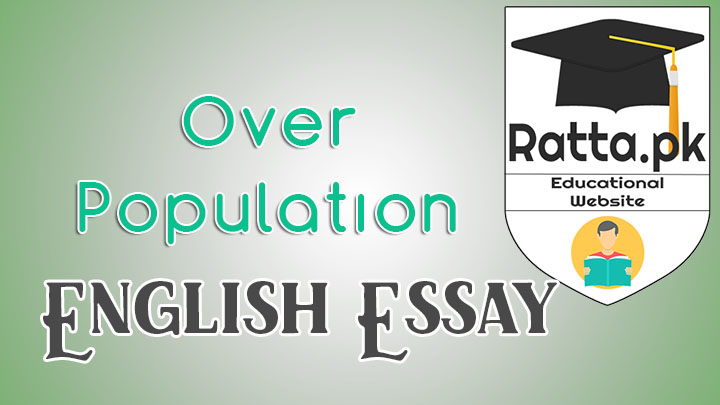
POPULATION EXPANSION AS A SOCIAL PROBLEM
Factors of population growth, causes of population expansion, i. cultural value: , ii. polygyny: , iii. desire of male child: , iv. islamic laws: , v. remarriage of widow: , vi. climatic conditions: , vii. lack of recreation:, viii. desire of male child: , ix. having large family size: , x. reduction in mortality rate: , xi. better health facilities: , xii. better food: , xiii. control on epidemics: , xiv. early marriages: , impacts of population growth, steps to reduce population growth, i. reduction in population growth rate: , ii. technical education: , iii. ending of non working: , iv. population planning programs: , v. conscious and awareness campaigns: , vi. optimum use of human resources: , vii. women employment: , viii. promotion of education: , you may also like:.

About Maher Afrasiab
Hello, I am Maher Afrasiab a founder of Ratta.pk and some other websites. I have created ratta.pk to promote the eductaion in Pakistan. And to help the students in their studies. Find me on Facebook: @Maher Afrasiab
3 comments:

- English Learning Notes
- History Notes
- English Essays
- General knowledge
- Guess Papers

Ameer Notes
Search this blog, essay on causes of overpopulation with outlines and thesis statement., essay: causes of overpopulation in pakistan (750-800 words), thesis statement.
The human different non-progressive behaviors led to the causes of population explosion in Pakistan.
- Introduction
- Current scenario of population in Pakistan
2.1 Causes of overpopulation
2.2 Women are not in workforce
2.3 Early marriages cause increase in population
2.4 Government failed spread awareness
2.5 Religious teachings encourage increase in population
3. Conclusion
"If the world is to save any part of its resources for the future, it must reduce not only consumption but the number of consumers." B.F.Skinner
Overpopulation means number of populations jumps higher than the available resources of country. In stone ages and agrarian societies people believe a greater number of manpower in order to be strong both socially and economically. The mindset is continuing in Pakistan even in postindustrial society. People still believe large population is symbol of power and strength. Unfortunately, Pakistan is one of those countries where the population is much larger than its economy. The human of Pakistan’s different non-progressive behavior led to the causes of population explosion. The main causes of overpopulation in Pakistan is lack of women participation in workforce, early marriages, failure of government to sensitized people and religious teachings that encouraged people to increase population.
Comparing the population of Muslims countries, According to World Bank Pakistan is leading in population growth rate with 1.89 percent leaving behind Bangladesh, Indonesia, Iran, Turkey, Morocco, Egypt and Malaysia at a growth rate between 1.2 to 1.6 percent. Pakistan’s population was 33 million in 1947. It was among those countries that started family planning program 1960s. Although Pakistan not a stable country right after independence but with next 15 years it develops very fast due to low population. Now, it is the 5th largest population in the world and one of the worst in economies. Population census 2017 reported that 207.68 million people living in Pakistan. According to the experts, under the same growth rate, the population of Pakistan would be greater than of China by the year 2035.
First, women are very less in workforce in Pakistan due to cultural pattern of pattern. The male dominant society discourages women participation in workforce. Women are expected the look after household jobs. House wives are mothers of many children as compare to those women who are busy to advancement of their career at offices. Thus, lack of women participation in workforce causes population rate high.
Second, early marriages cause population expansion. UN Women reported in 2020 that Pakistan has the 6th highest number of girls that married before the age of 18 in the world. Those girls who married early age usually have many children. As soon as a girl grow parent start thinking of their marriage because it is a general perception in society that girls should be married in early age. Although, early marriages are not allowed by law of Pakistan but it is very common all over the country. Those who are convinced regarding early marriages they have religious justification. Therefore, early marriage trend in Pakistan increasing the population of the country.
Third, government as an institution failed to aware masses to control birth rate. Government has resources for advertisement but normally it not visible anywhere. State has relevant institution but they are not functional. Actually, politicians, government officials and other school of thought inspired from religious teachings that is why their approach to population control projects are very passive All in all, institution of the state unsuccessful to aware people to use population-controlled methods.
Finally, religious factors playing a strong role to increase population in Pakistan. The poor believe that God will arrange food for their children so with that hope people are motivated to increase the number of their family members. Islamic teachings boost Muslims to increase Islamic community in order to strengthening the Islam. Islam also encourage polygamy therefore population increase and multiplies. Hence, Islamic teachings are source of inspiration for people to increase the Ummah.
To summarize, overpopulation cause in Pakistan by attitude of people and government. Common people believe women should stay at home and control the affair of kitchen and children. Early marriages playing major role to boost the population. Government failed to aware the masses to control the birth-rate because it is not the priority of state to sensitizes masses in this regard. Furthermore, religion as a most dominant institution encourage people to increase the number of Muslims community. However, increase in population is not always a negative impact, China has proved that large population can contribute the progress and development of country, if many dominant factors not controlling to birth rate then government should adopt china’s policy to develop the nation.
Popular Posts of last 7 days
Salient features of khutba hujjat ul wida - last sermon of the holly prophet pbuh, what is gcss - geographic coverage support system, the war of independence 1857 solved notes for css, pcs , pms and other competitive exams, partition of bengal 1905 notes - css,pms and pcs, 14 points of muhammad ali jinnah in simplest words, essay on pakistan's economy, objective resolution 1949 [ solved answer for competitive exams ].
- Privacy Policy
Zong Helpline Number, Customer Care
Gfc fan price in pakistan 2024, close comfort air conditioner ac price in pakistan, specification, overpopulation in pakistan essay.
We all know that Pakistan is known out to be one of the fastest growing countries in the world. If we look back in the past then the population of Pakistan in the year 1994 was estimated to be 126 million. At that time of year Pakistan was counted to be the ninth most populous country of the world. It has been founded that almost 2 percent of the world’s population living on top of less than 0.7 percent of the world’s land. Today the population growth of Pakistahn is captured to be one ofteh highest in the whole world. It is officially estimated at 3.1 percent per year increase in the populationof Pakistan. But now this percentage has travelled in the limit of 3.3 percent per year as many planners have been involved in population programs.

About Overpopulation In Pakistan:
If we talk about the latest survey, Pakistan’s population has reached up to 174.59 Million. In this way Pakistan is following Russia and Brazil in the population growth that is quite disturbing situation. It has been estimated that in the year 2024 Pakistan population will going to reach 208 Million. Even today as well almost 20% of our population is witnessed to be living below international poverty line earning in the region of 1.25 $ per day.
Following are some of the main causes that are giving high rise to the over-population in Pakistan:
- One of the main reasons of the over-population in Pakistan is the unbalanced growth rate. In Pakistan people are not well aware from he concept of the family planning and this is the main root cause that give rise to the over-population.
- Government is not setting up the enough budgets that will let the people know about the concept of population growth. People belonging to the rural areas are not aware from the disadvantages of extra ordinary birth rate.
- Above all we have so far captured that most of the people are moving their ways in the cities that is making the villages less-populated. In this way in order to increase the population of the villages the families are raising the children without any planning.
According to the reports that have been conducted by the Ministry of Health Pakistan it has been captured that there were 13,937 health institutions in the country adding with 945 hospitals, 4,755 dispensaries, 5,349 Basic Health Units (mostly in rural areas), 903 Mother and Child Care Centers, 562 rural health centers and 290 TB centers. Well all in all we would say that special measures have to be taken to control the increase of population as quickly as possible.
Related Posts
Suraj grahan in pakistan 2024 date and time, how to unsubscribe zong, ufone, telenor, mobilink caller tunes, zong advance balance code 2024 for loan, rana resort ticket price 2024, location, contact number, 1st may labour day essay in urdu, may 1 labor day whatsapp status, wishes, quotes, shayari in urdu.
Very nice because they help us
It was kind of helpful ?
given picture is very nice …!
Good effort and your given picture is too good, i like it.!!
Save my name, email, and website in this browser for the next time I comment.
Type above and press Enter to search. Press Esc to cancel.
Ad Blocker Enabled!
Home | Science | Sociology | Society | Social Issues | Overpopulation
Overpopulation in Pakistan Reflective Essay
- Updated July 25, 2023
- Pages 7 (1 682 words)
- Views 1,214
- Social Issues
- Overpopulation
- Any subject
- Within the deadline
- Without paying in advance
Table of Contents
Overpopulation in Pakistan
Causes of overpopulation, allah is raziq, low per capita income, increase in birth rate, religious constraints, high growth rate, need for more earning hands, absence of family planning, urbanziation, afghan refugees, effects of overpopulation in pakistan, unemployment, increase in crime rate, depletion of natural resources, degradation of our environment, increasing spread of diseases, shortage of food, water ahortage due to overpopulation, solutions for overpopulation.
Overpopulation is a condition in which the number of existing human population exceeds the carrying capacity of earth. It is an undesirable condition. Overpopulated countries face many problems. There are various factors that become the cause of overpopulation in a country. Reduced mortality rate, better medical facilities, depletion of precious resources are few of the causes which results in overpopulation. It is possible for a sparsely populated area to become densely populated if it is not able to sustain life.
Pakistan is listed in the 10 most populated countries in the world with a large population of young adults and children. In the year 1950, the population of Pakistan was 33 million and the rank of Pakistan was 14th in the world. But today, there is an immense increase in its population. Its population is about 210 million and its rank is 6th in the world. According to the latest UN reports, the population of Pakistan will turn to 300 million in the year 2050. This increase in population is causing problems for the people of Pakistan.
There are many factors which become the cause of overpopulation in Pakistan. Some of them are listed below:
Most of the Muslims have a very strong belief is that Allah gives food to everyone. He provides food to even an ant living in a stone. So they think that Allah will give food to every member of their family so they don’t reduce the size of their families.
If we divide national income on total population, we get per capita income. Low per capita income shows population explosion. Per capita income in Pakistan is $1254.
In Pakistan, birth rate is high as compared to death rate which is causing increase in population.
In Pakistan, population is increasing due to religious constraints. Many imams prohibit family planning and use of contraceptives which is the reason behind the increase of overpopulation.
High growth rate of a country shows overpopulation. Growth rate of population in Pakistan is 2.1%. It is one of the causes of overpopulation in Pakistan.
In a developing country like Pakistan, a single person cannot earn enough money to support his whole family. People think that if they will have more children than they will have more earning hands. As a result, it causes overpopulation.
Illiteracy is one of the factors that become the cause of overpopulation. Literacy rate is 57.7% in Pakistan. Due to lack of education, most people do not understand that a high birth rate will increase their economic problems.
Most of the people are not aware of the term family planning. People are not familiar with the methods of family planning. They also feel hesitant to consult a doctor. So it causes overpopulation.
Urbanization is also one of the contributing factors towards overpopulation in Pakistan. Due to less job facilities in the rural areas, a large number of people migrate towards cities every year.
This causes an increase in the urban population and the cities which have more job facilities become overpopulated.
An arrival of Afghan refugees from India and Afghanistan is also causing overpopulation in Pakistan.
Population is increasing day by day in Pakistan and it is causing drastic effects. Some of the effects of overpopulation in Pakistan are described below:
With the increase of population, the pollution is also increasing in Pakistan. As the population increases, the number of vehicles on the road also increases. These vehicles release harmful chemicals in the environment that mix with the air and become the source of pollution. With the increase of population, the household waste also increases. These waste products are released in the water bodies and are also thrown on the roads without any check and balance. This becomes the cause of land and water pollution which is very injurious for human health. The graph below shows the rate of water pollution in different cities of Pakistan and this pollution is caused by overpopulation.
When a country becomes overpopulated, the rate of unemployment increases in that country. Pakistan is an overpopulated country so that’s why most of its people are unemployed because. Government cannot provide enough jobs to a large number of people in various sectors. That’s why we can say that overpopulation and unemployment are closely linked.
As discussed above, unemployment increases because of overpopulation. Rise in unemployment will give rise to crime as people will steal in order to gain their food and in order to gain money.
Dr Fateh Muhammad Burfat in a seminar stated that: “An increase in population generates a scarcity of resources which in turn gives rise to unequal distribution of the resources which engenders intolerance among the deprived classes, finally culminating in a surge in crimes.”
Due to overpopulation, the consumption of natural resources becomes more as compared to their production. The natural resources become depleted because the earth can produce only the limited amount of water and food. So, Pakistan is also facing depletion of its resources because of overpopulation.
With the increase of population, the environmental degradation also increases. Wood is needed by the people to make huts, to make furniture and wood is needed in the making of many other goods. So as the number of people increases, the need for wood also increases, so it causes an increase in deforestation (cutting down of trees to obtain wood). Deforestation has led to many environmental hazards in Pakistan. It has decreased the amount of oxygen in the air and on the other hand, amount of carbon dioxide is increasing. It is causing global warming in Pakistan which is a serious environmental hazard. So, we can say that environmental hazards have also increased due to increase of population.
Due to overpopulation, environmental hazards are also increased. These increasing hazards are causing spread of many diseases in Pakistan. Wastes are discharged in the landfills without any check and balance. Industries release their waste in the rivers and streams. It causes water and air pollution and it becomes the cause of spread of many diseases such as malaria, water borne diseases etc.
Overpopulation has led to increase of poverty in Pakistan. A large number of people in our country do not have proper place to live. Due to this, number of beggars has also increased in our country because they do not have shelters to live and food to eat. Overpopulation is causing worst economic conditions due to which poverty increases. Population is increasing rapidly but many people are unemployed due to which they live in poor economic conditions and they face poverty.
Pakistan is an agricultural country but it is facing shortage of food due to overpopulation. Agriculture sector is the backbone of Pakistan’s economy but in the recent years, the performance of this sector has declined sharply. Food is a basic requirement of human being and without it people will unable to survive. In Pakistan, problem of food shortage is increases day by day. Different factors are involved in food shortage. The agriculture GDP growth rate in
Pakistan is significantly lower than the population growth rate. According to the recent reports, there are 48 countries in the world which suffer from food shortage and Pakistan is ranked 16th.
The main reason behind this is the increase in population due to which there is less food and more mouths to eat.
From the recent years, Pakistan is facing water problems. In Pakistan, the current availability of water is only 178 billion cubic meters which is estimated at 860 cubic meters per capita. This is an alarming condition for Pakistan and it is directly related to overpopulation. Because with the increase of population, the consumption of water increases more than the availability of water, so it is the cause of water crisis of Pakistan.
- In Pakistan, awareness should be provided about the family planning.
- People should be educated about the harmful impacts of overpopulation on the economy of the country.
- Gender discrimination is the also the reason of overpopulation in Pakistan. People desire to have more sons as compared to daughters. If we will eliminate gender discrimination, population can be controlled.
- Women empowerment can be a big step towards population control in Pakistan.
As a conclusion, we can say that population increase is one of the contemporary issues in Pakistan which is also responsible for the poor economic status of this country. Today, Pakistan is facing food shortage and water and energy crisis. Present age is the age of great revolutions but still in this age, many children die each year due to lack of food and water in agricultural country like Pakistan. In addition, some Pakistanis marry very early and are polygamous, a practice claimed to poorly affect the standard of living. The Pakistani education system is very poor and the government seems unwilling or unable to make effective changes. Moreover, poverty, inflation, illiteracy, social unrest, and criminality are the cases in point that are created by overpopulation. Therefore, the government of Pakistan needs to devote not only adequate time and attention to these issues but to implement real change and reform to solve the overpopulation crisis. If we want to make progress in certain fields, we should take steps to control population because it has reached to alarming levels in Pakistan.
- Slowing Pakistan’s Population Growth Critical for Building Prosperous Future – The World Bank
- Pakistan’s Overpopulation Challenge – The Express Tribune
- Allah is Raziq: Pakistani Population Growth and Religious Beliefs – Dawn
- Causes and Consequences of Unchecked Growth in Pakistan – The World Bank
- Causes of Population Growth in Pakistan – Pakistan Bureau of Statistics
- Pakistan Must Focus on Controlling Population Growth – Business Recorder
- Can Overpopulation be Really a Reason for Economic Woes in Pakistan? – Pakistan Today
Cite this paper
Overpopulation in Pakistan Reflective Essay. (2020, Sep 05). Retrieved from https://samploon.com/overpopulation-in-pakistan/

- Select a writer from a large pool of experts
- Share your assignment's requirements
- Get a 100% unique and top-quality paper
Check related topics

Hi! Peter is on the line!
Don't settle for a cookie-cutter essay. Receive a tailored piece that meets your specific needs and requirements.
- International edition
- Australia edition
- Europe edition

Indian government ordered killings in Pakistan, intelligence officials claim
Allegations of up to 20 assassinations since 2020 follow Canada’s accusation of Delhi role in murders of dissidents
The Indian government assassinated individuals in Pakistan as part of a wider strategy to eliminate terrorists living on foreign soil, according to Indian and Pakistani intelligence operatives who spoke to the Guardian.
Interviews with intelligence officials in both countries, as well as documents shared by Pakistani investigators, shed new light on how India’s foreign intelligence agency allegedly began to carry out assassinations abroad as part of an emboldened approach to national security after 2019. The agency, the Research & Analysis Wing (Raw), is directly controlled by the office of India’s prime minister, Narendra Modi, who is running for a third term in office in elections later this month.
The accounts appear to give further weight to allegations that Delhi has implemented a policy of targeting those it considers hostile to India. While the new allegations refer to individuals charged with serious and violent terror offences, India has also been accused publicly by Washington and Ottawa of involvement in the murders of dissident figures including a Sikh activist in Canada and of a botched assassination attempt on another Sikh in the US last year.
The fresh claims relate to almost 20 killings since 2020, carried out by unknown gunmen in Pakistan. While India has previously been unofficially linked to the deaths, this is the first time Indian intelligence personnel have discussed the alleged operations in Pakistan, and detailed documentation has been seen alleging Raw’s direct involvement in the assassinations.
The allegations also suggest that Sikh separatists in the Khalistan movement were targeted as part of these Indian foreign operations, both in Pakistan and the west.
According to Pakistani investigators, these deaths were orchestrated by Indian intelligence sleeper-cells mostly operating out of the United Arab Emirates. The rise in killings in 2023 was credited to the increased activity of these cells, which are accused of paying millions of rupees to local criminals or poor Pakistanis to carry out the assassinations. Indian agents also allegedly recruited jihadists to carry out the shootings, making them believe they were killing “infidels”.

According to two Indian intelligence officers, the spy agency’s shift to focusing on dissidents abroad was triggered by the Pulwama attack in 2019 , when a suicide bomber targeted a military convoy in Indian-administered Kashmir, killing 40 paramilitary personnel. The Pakistan-based terror group Jaish-e-Mohammed claimed responsibility.
Modi was running for a second term at the time and was brought back to power in the aftermath of the attack.
“After Pulwama, the approach changed to target the elements outside the country before they are able to launch an attack or create any disturbance,” one Indian intelligence operative said. “We could not stop the attacks because ultimately their safe havens were in Pakistan, so we had to get to the source.”
To conduct such operations “needed approval from the highest level of government”, he added.
The officer said India had drawn inspiration from intelligence agencies such as Israel’s the Mossad and Russia’s KGB, which have been linked to extrajudicial killings on foreign soil. He also said the killing of the Saudi journalist and dissident Jamal Khashoggi, who was murdered in 2018 in the Saudi embassy, had been directly cited by Raw officials.
“It was a few months after the killing of Jamal Khashoggi that there was a debate among the top brass of intelligence in the prime minister’s office about how something can be learned from the case. One senior officer said in a meeting that if Saudis can do this, why not us?” he recounted.
“What the Saudis did was very effective. You not only get rid of your enemy but send a chilling message, a warning to the people working against you. Every intelligence agency has been doing this. Our country cannot be strong without exerting power over our enemies.”
Senior officials from two separate Pakistani intelligence agencies said they suspected India’s involvement in up to 20 killings since 2020. They pointed to evidence relating to previously undisclosed inquiries into seven of the cases – including witness testimonies, arrest records, financial statements, WhatsApp messages and passports – which investigators say showcase in detail the operations conducted by Indian spies to assassinate targets on Pakistani soil. The Guardian has seen the documents but they could not be independently verified.

The intelligence sources claimed that targeted assassinations increased significantly in 2023, accusing India of involvement in the suspected deaths of about 15 people, most of whom were shot at close range by unknown gunmen.
In a response to the Guardian, India’s ministry of external affairs denied all the allegations, reiterating an earlier statement that they were “false and malicious anti-India propaganda”. The ministry emphasised a previous denial made by India’s foreign minister, Subrahmanyam Jaishankar, that targeted killings in other countries were “not the government of India’s policy”.
In the killing of Zahid Akhund , an alias for the convicted Kashmiri terrorist Zahoor Mistry who was involved in the deadly hijacking of an Air India flight, the Pakistani documents say a Raw handler allegedly paid for information on Akhund’s movements and location over a period of months. She then allegedly contacted him directly, pretending to be a journalist who wanted to interview a terrorist, in order to confirm his identity.
“Are you Zahid? I am a journalist from the New York Post,” read messages in the dossier shown to the Guardian. Zahid is said to have responded: “For what u r messaging me?”
Millions of rupees were then allegedly paid to Afghan nationals to carry out the shooting in Karachi in March 2022. They fled over the border but their handlers were later arrested by Pakistani security agencies .
According to the evidence gathered by Pakistan, the killings were regularly coordinated out of the UAE, where Raw established sleeper cells that would separately arrange different parts of the operation and recruit the killers.
Investigators alleged that millions of rupees would often be paid to criminals or impoverished locals to carry out the murders, with documents claiming that payments were mostly done via Dubai. Meetings of Raw handlers overseeing the killings are also said to have taken also place in Nepal, the Maldives and Mauritius.
“This policy of Indian agents organising killings in Pakistan hasn’t been developed overnight,” said a Pakistani official. “We believe they have worked for around two years to establish these sleeper cells in the UAE who are mostly organising the executions. After that, we began witnessing many killings.”

In the case of Shahid Latif , the commander of Jaish-e-Mohammed and one of India’s most notorious militants, several attempts were allegedly made to kill him. In the end, the documents claim, it was an illiterate 20-year-old Pakistani who carried out the assassination in Pakistan in October, allegedly recruited by Raw in the UAE, where he was working for a minimal salary in an Amazon packing warehouse.
Pakistani investigators found that the man had allegedly been paid 1.5m Pakistani rupees (£4,000) by an undercover Indian agent to track down Latif and later was promised 15m Pakistani rupees and his own catering company in the UAE if he carried out the killing. The young man shot Latif dead in a mosque in Sialkot but was arrested soon after, along with accomplices.
The killings of Bashir Ahmad Peer , commander of the militant outfit Hizbul Mujahideen, and Saleem Rehmani, who was on India’s most-wanted list, were also allegedly planned out of the UAE, with transaction receipts from Dubai appearing to show payments of millions of rupees to the killers. Rehmani’s death had previously been reported as the result of a suspected armed robbery .
Analysts believe Pakistani authorities have been reluctant to publicly acknowledge the killings as most of the targets are known terrorists and associates of outlawed militant groups that Islamabad has long denied sheltering.
In most cases, public information about their deaths has been scant. However, Pakistani agencies showed evidence they had conducted investigations and arrests behind closed doors.
The figures given to the Guardian match up with those collated by analysts who have been tracking unclaimed militant killings in Pakistan. Ajay Sahni, the executive director of the Institute for Conflict Management in Delhi, said his organisation had documented 20 suspicious fatalities in Pakistan by unknown attackers since 2020, though two had been claimed by local militant groups. He emphasised that because of Pakistan’s refusal to publicly investigate the cases – or even acknowledge that these individuals had been living in their jurisdiction – “we have no way of knowing the cause”.
“If you look at the numbers, there is clearly a shift in intent by someone or other,” said Sahni. “It would be in Pakistan’s interest to say this has been done by India. Equally, one of the legitimate lines of inquiry would be possible involvement of the Indian agencies.”
Pakistan’s foreign secretary, Muhammad Syrus Sajjad Qazi, publicly acknowledged two of the killings in a press conference in January, where he accused India of carrying out a “sophisticated and sinister” campaign of “extraterritorial and extrajudicial killings” in Pakistan.
Islamabad’s accusations were met with scepticism by others, due to the longstanding animosity between the two neighbouring countries who have gone to war four times and have often made unsubstantiated accusations against the other.
For decades India has accused Pakistan of bankrolling a violent militant insurgency in the disputed region of Indian-administered Kashmir and of giving a safe haven to terrorists. In the early 2000s, India was hit by successive terrorist attacks orchestrated by Pakistan-based Islamist militant groups, including the 2006 Mumbai train blasts , which killed more than 160 people, and the 2008 Mumbai bombings , which killed 172 people.
Both countries are known to have carried out cross-border intelligence operations, including small bomb blasts. However, analysts and Pakistani officials described the alleged systematic targeted killings of dissidents by Indian agents on Pakistani soil since 2020 as “new and unprecedented”.
The majority of those allegedly killed by Raw in Pakistan in the past three years have been individuals associated with militant groups such as Lashkar-e-Taiba and Jaish-e-Mohammed, and in several cases have convictions or proven links to some of India’s deadliest terrorist incidents, which have killed hundreds of people. Others were seen to be “handlers” of Kashmiri militants who helped coordinate attacks and spread information from afar.
According to one of the Indian intelligence officers, the Pulwama attack in 2019 prompted fears that militant groups in Pakistan were planning a repeat of attacks such as the 2008 Mumbai bombings.
“The previous approach had been to foil terrorist attacks,” he said. “But while we were able to make significant progress in bringing the terrorist numbers down in Kashmir, the problem was the handlers in Pakistan. We could not just wait for another Mumbai or an attack on parliament when we are aware that the planners were still operating in Pakistan.”
In September, the Canadian prime minister, Justin Trudeau, told parliament there were “credible allegations” that Indian agents had orchestrated the killing of Hardeep Singh Nijjar, a prominent Sikh activist who was gunned down in Vancouver. Weeks later, the US Department of Justice released an indictment vividly detailing how an Indian agent had attempted to recruit a hitman in New York to kill another Sikh activist, later named as Gurpatwant Singh Pannun.

Both men had been major advocates of the Khalistan movement , which seeks to create an independent Sikh state and is illegal in India. India denied any involvement in the killing of Nijjar, while according to a recent report , India’s own investigation into the Pannun plot concluded that it had been carried out by a rogue agent who was no longer working for Raw.
According to one Indian intelligence official, Delhi recently ordered the suspension of targeted killings in Pakistan after Canada and the US went public with their allegations. No suspicious killings have taken place so far this year.
Two Indian operatives separately confirmed that diaspora Khalistani activists had become a focus of India’s foreign operations after hundreds of thousands of farmers, mostly Sikhs from Punjab, descended on Delhi to protest against new farm laws. The protest ultimately forced the government into a rare policy U-turn, which was seen as an embarrassment .
The suspicion in Delhi was that firebrand Sikh activists living abroad, particularly those in Canada, the US and the UK, were fuelling the farmers’ protests and stirring up international support through their strong global networks. It stoked fears that these activists could be a destabilising force and were capable of reviving Khalistani militancy in India.
“Places were raided and people were arrested in Punjab, but things were actually being controlled from places like Canada,” said one of the Indian intelligence operatives. “Like other intelligence agencies, we had to deal with it.”
In the UK, Sikhs in the West Midlands were issued “threat to life” warnings, amid growing concern about the safety of separatist campaigners who Sikhs claim are being targeted by the Indian government.

Before the US and Canadian cases, a high-profile Khalistani leader, Paramjit Singh Panjwar , was shot dead in Lahore last May. Pakistani investigators claimed they had warned Panjwar that his life was in danger a month before he was killed and said another Khalistani activist living in Pakistan has also faced threats to his life.
Panjwar’s assassination is among those alleged to have been carried out by Indian operatives using what Pakistani agencies described as the “religious method”. According to the documents, Indian agents used social media to infiltrate networks of Islamic State (IS) and units connected to the Taliban, where they recruited and groomed Pakistani Islamist radicals to carry out hit jobs on Indian dissidents by telling them they were carrying out “sacred killings” of “infidels”.
These agents allegedly sought help from former IS fighters from the Indian state of Kerala – who had travelled to Afghanistan to fight for IS but surrendered after 2019 and were brought back through diplomatic channels – to get access to these jihadist networks.
According to an investigation by the Pakistani agencies, Panjwar’s killer, who was later caught, allegedly thought he was working on the instructions of the Pakistan Taliban affiliate Badri 313 Battalion and had to prove himself by killing an enemy of Islam.
The killing of Riyaz Ahmad , a top Lashkar-e-Taiba commander, in September last year was allegedly carried out by Raw in a similar manner. His killer, Pakistan believes, was recruited through a Telegram channel for those who wanted to fight for IS, and which had been infiltrated by Raw agents.
They have claimed the assassin was Muhammad Abdullah, a 20-year-old from Lahore. He allegedly told Pakistani investigators he was promised he would be sent to Afghanistan to fight for IS if he passed the test of killing an “infidel” in Pakistan, with Ahmed presented as the target. Abdullah shot and killed Ahmed during early morning prayers at a mosque in Rawalkot, but was later arrested by Pakistani authorities.
Walter Ladwig, a political scientist at King’s College London, said the alleged shift in strategy was in line with Modi’s more aggressive approach to foreign policy and that just as western states have been accused of extrajudicial killings abroad in the name of national security, there were those in Delhi who felt “India reserves the right to do the same”.
Daniel Markey, a senior adviser on south Asia at the United States Institute of Peace, said: “In terms of India’s involvement, it all kind of adds up. It’s utterly consistent with this framing of India having arrived on the world stage. Being willing to take this kind of action against perceived threats has been interpreted, at least by some Indians, as a marker of great power status.”
The allegations of extrajudicial killings, which would violate international law, could raise difficult questions for western countries that have pursued an increasingly close strategic and economic relationship with Modi and his Hindu nationalist Bharatiya Janata party (BJP) government, including pushing for intelligence-sharing agreements.
A former senior Raw official who served before Modi’s premiership denied that extrajudicial killings were part of the agency’s remit. He confirmed that nothing would be done without the knowledge of the national security adviser, who would then report it to the prime minister, and on occasion they would report directly to the prime minister. “I could not do anything without their approval,” he said.
The former Raw official claimed that the killings were more likely to have been carried out by Pakistan themselves, a view that has been echoed by others in India.
Pakistani agencies denied this, pointing to a list of more than two dozen dissidents living in Pakistan to whom they had recently issued direct warnings of threats to their lives and instructed them to go into hiding. Three individuals in Pakistan said they had been given these warnings. They claimed others who had not heeded the threats and continued their normal routines were now dead.
- South and central Asia
Most viewed

IMAGES
VIDEO
COMMENTS
JOIN OUR WHATSAPP CHANNEL. LAHORE: A ticking time bomb of population growth threatens Pakistan, joining the league of the world's top five most populous countries, with a staggering 225 million ...
The consequences of overpopulation in Pakistan can be far-reaching and have a significant impact on the country's social, economic, and environmental well-being. Some of the main consequences include: Strain on resources: Overpopulation puts a strain on resources such as food, water, and energy, leading to shortages and higher prices.
At the time of its independence, Pakistan had a population of 31 million. However, by the year 1995 the number had risen at a staggering speed and reached 140 million. [1] Presently, Pakistan has a population size of 225,199,929 with a growth rate of 1.9%. [2] The United Nations has predicted that at this rate Pakistan will hit the 380 million ...
Pakistan's total population is 177.1 million, up from 173.5 million the previous year, according to the Pakistan Economic Survey 2010-11. Pakistan ranks sixth among the world's most populous countries, with a population growth rate of 2.1 percent. Now let's discuss the main causes of overpopulation in Pakistan.
Daily Updates of the Latest Projects & Documents. At a time when many developing countries are experiencing a rapid decline in their fertility rates, Pakistan's remains almost as high today as it was twenty years ago. .
Pakistan is the sixth most populous country in the world with its population estimated at 207.8 million in 2017. Its population growth rate of 2.40 percent is the highest in South Asia and stands in sharp contrast to the 1.0-1.5 percent growth rate of other South Asian countries. Pakistan's population has increased by more than six-folds since the first post-independence census held in 1951.
Evidence: According to the Pakistan Bureau of Statistics Report, 2020, "The number of all reported crimes has increased from 0.64 million in 2010 to 0.87 million in 2020; likewise, its population figures were 194.5 million in 2010 and 227.2 in 2020.". 5- Solutions to Manage the Overpopulation Disaster in Pakistan. To increase the literacy rate.
Background Pakistan is the fifth most populous country in the world, with a population that is growing at 2.4% annually. Despite considerable political will, including a national commitment that ...
Currently, Pakistan has a population of 207.7 million and is the 6th most populous country in the world after China, India, USA, Indonesia, and Brazil. During the intercensal period of 1998 to 2017, Pakistan's population increased by 57 percent, with an average annual growth rate of 2.4 percent. Whereas during the previous intercensal period ...
Challenges of overpopulation in pakistan. November 20, 2023. Opinions, Letters, Newspaper. The surge in human resources demands parallel growth in a nation's population, playing a pivotal role in its economic and social trajectory. In Pakistan, this intricate relationship manifests as both a producer and a consumer of human capital.
In Third World countries like Pakistan, overpopulation amplifies and afflicts profound suffering to the well-being of people. Therefore, addressing the issue of population explosion and tackling its resultant effects is the immense need of the hour. The overpopulation crisis has led the country to the brink of an economic explosion.
This is an essay on "Population explosion in Pakistan" for CSS, PMS, and All Judiciary examinations. Increasing Population is a serious issue in today's modern world. ... So, a decline in the death rate has in other words led to the problem of overpopulation. Pakistan is a developing country and like many others like it is trying hard to ...
This essay explores the causes and consequences of overpopulation, delves into implicit results, and highlights the necessity of global collaboration. Overpopulation, simply put, occurs when the number of people in a specific area exceeds the capacity of the environment to support life at a decent standard.
500 Words Essay On Overpopulation. Overpopulation refers to an undesirable condition in which the number of existing human being exceeds the actual carrying capacity of the earth. It has many causes which range from a decline in the death rate to early marriages and more. The overpopulation essay will throw light on this issue.
The birthrate and death rate are significantly different: The high birthrate and low death rate both contribute to Pakistan's overpopulation problem. At 27.7 births per 1,000 people, the birthrate in Pakistan is one of the highest in the world outside of Africa. By comparison, Pakistan's death rate is 7.228 per 1,000.
This is an essay on "Overpopulation" for CSS, PMS, and All Judiciary examinations. Overpopulation or overabundance occurs when a species' population becomes so excessive that people deem it must be managed. It can result from an increase in births, a decline in the mortality rate, an increase in immigration, or a depletion of resources.
The main effect of over population is unemployment and its rate in Pakistan is 5.6% which is because it is impossible to provide jobs in such overpopulated countries. There is a high rate of inflation as there is more demand for goods due to more population which results in more prices and inflation in the country. Rate is 14.1% in Pakistan.
The rate of population growth is 2.6% annual. During 1981 census, the population of Pakistan was 87 millions. It means the Population has been expanding at a rate of 2.6% annually. The death rate is 11 per 1000 and the birth rate is 44 per 1000. it means the natural increase in population is as: 44-11=33.
We shall deal with the educational factors as an affect of overpopulation rather than the cause. The growth rate of population is the focal point the economic development of a country. The growth rate of Pakistan is 2.09 %. ( See table 3.1 & fig 3.3).The growth rate reached its peak in 1972 and it has been continuously declining over the years.
The population of Pakistan according to the Last united nation survey estimate (July 1, 2019) is about 216,565,318, Births per day are 16,433, Deaths per day are 4,069, net migrations per day is (-622), and net change per day is 11,742. Economic development is the process; in which production increased of a country at a particular time period.
Essay: Causes of Overpopulation in Pakistan (750-800 Words) Thesis statement . The human different non-progressive behaviors led to the causes of population explosion in Pakistan. Outline . Introduction; Current scenario of population in Pakistan ; 2.1 Causes of overpopulation. 2.2 Women are not in workforce. 2.3 Early marriages cause increase ...
About Overpopulation In Pakistan: If we talk about the latest survey, Pakistan's population has reached up to 174.59 Million. In this way Pakistan is following Russia and Brazil in the population growth that is quite disturbing situation. It has been estimated that in the year 2024 Pakistan population will going to reach 208 Million.
Overpopulation in Pakistan. Pakistan is listed in the 10 most populated countries in the world with a large population of young adults and children. In the year 1950, the population of Pakistan was 33 million and the rank of Pakistan was 14th in the world. But today, there is an immense increase in its population.
The Indian government assassinated individuals in Pakistan as part of a wider strategy to eliminate terrorists living on foreign soil, according to Indian and Pakistani intelligence operatives who ...